I started the last Patch News by saying summer had finally arrived. Well I got that wrong! We did have some brief spells of summery weather in July but also a lot of terrible days and record rainfall. Mowing continued as usual, mostly by the Friday fliers but on Fri 19th only Woody turned up (several away on holiday) so he mowed alone. Gold star for Woody!
The last few days of the month were hot and sunny, just as July should be so maybe August will be better, fingers crossed. Despite the poor weather there were some highlights with several new models being flown and Dwayne Pipe successfully ran the annual chuck glider competition which is always a popular event but more on that later.
When we first moved to our new field late last year there were a few concerns about interference from the nearby radio masts. These concerns proved to be groundless and there have been no problems with our transmitters using 2.4GHz. But when flying FPV (First Person View) the system uses 5.8GHz so as a test Dougal Entendre flew his FPV model between the masts last month and experienced no problems as all. I was slightly jealous that he’s done it before me so in early July I flew my FPV model between the masts in the opposite direction, from east to west. Like Dougal, there were no problems at all.
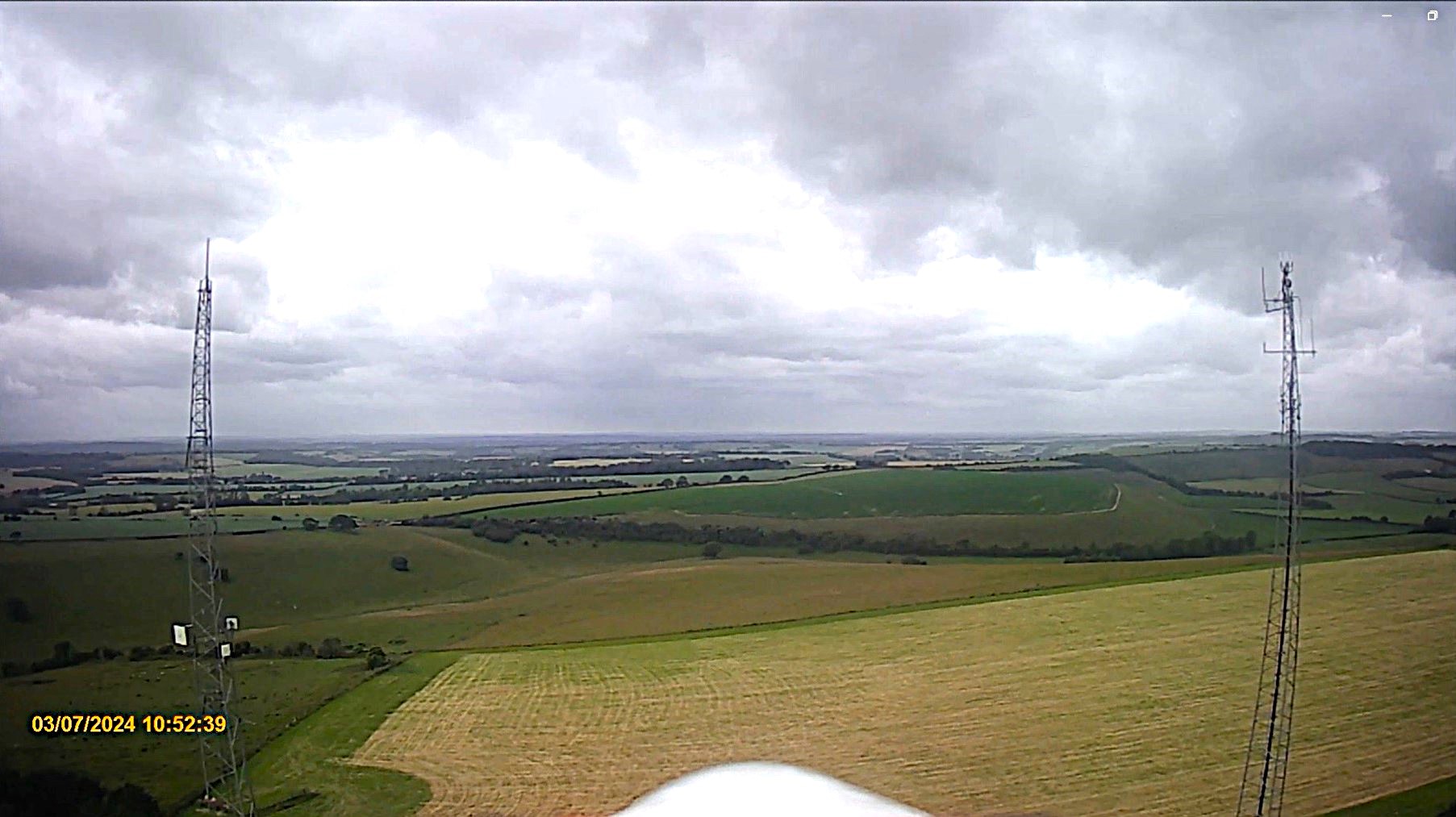 The farmer has told us that sometime this summer both masts will be replaced by a single larger one so I suppose the concerns will return until we’ve satisfied ourselves that there are no problems. First person to fly FPV around the new mast Dougal?
The farmer has told us that sometime this summer both masts will be replaced by a single larger one so I suppose the concerns will return until we’ve satisfied ourselves that there are no problems. First person to fly FPV around the new mast Dougal?
In June I asked the name of this plane that I’d seen at the RAF Manston History Museum: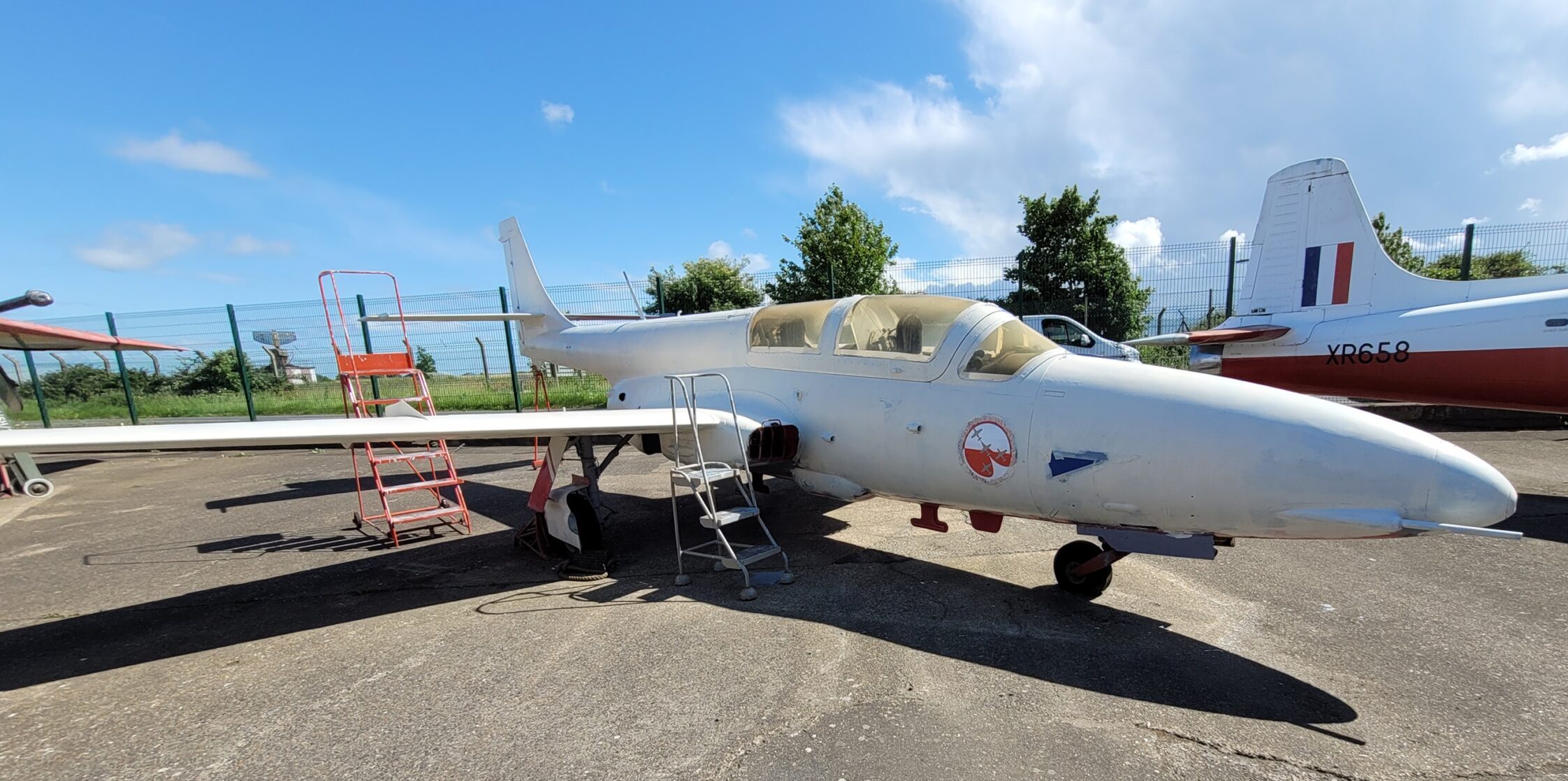
Nobody even had a guess so I’ll tell you, it’s a PZL TS-11 Iskra. I’ve never heard of it either!
So this month the quiz is to name this electric model. Rod Ashton received it as part of a lot of stuff he’s received from the widow of an aeromodelling friend. Nobody he has asked so far has a clue what it is so start searching, Rod would really like to know it’s name: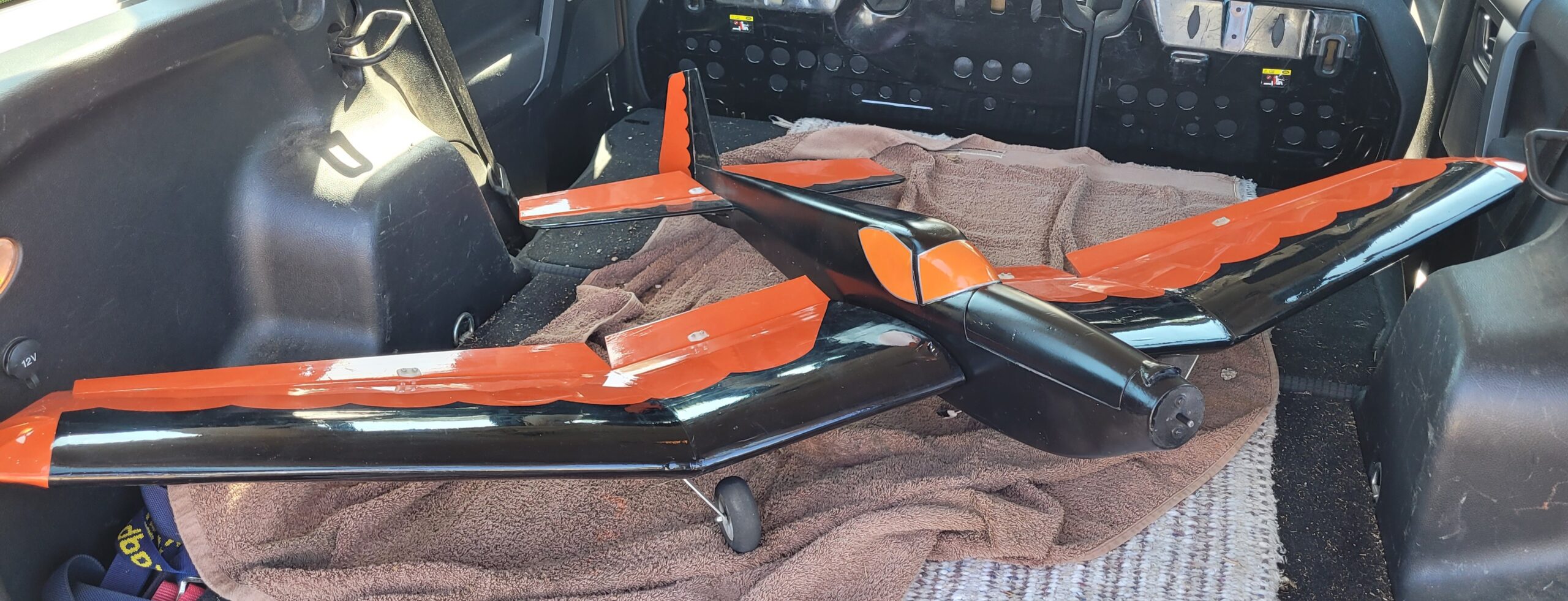
In May I featured Part 1 of 1066’s Fusion V2 build. It’s now flown so here’s Part 2:
By the time this makes the blog, the Fusion will have been flown, but having sent Colin some build photos in June we both thought some views on the build may be of interest. After building all the tail I moved on to the fin, rudder, and ailerons. Having built two kits this year I have noticed you have to be very careful with how you use the strip material supplied. On this build I only wasted 15 mm on each length of the 9mm x 6mm strip supplied for all the cross bracing, but still managed to run out.
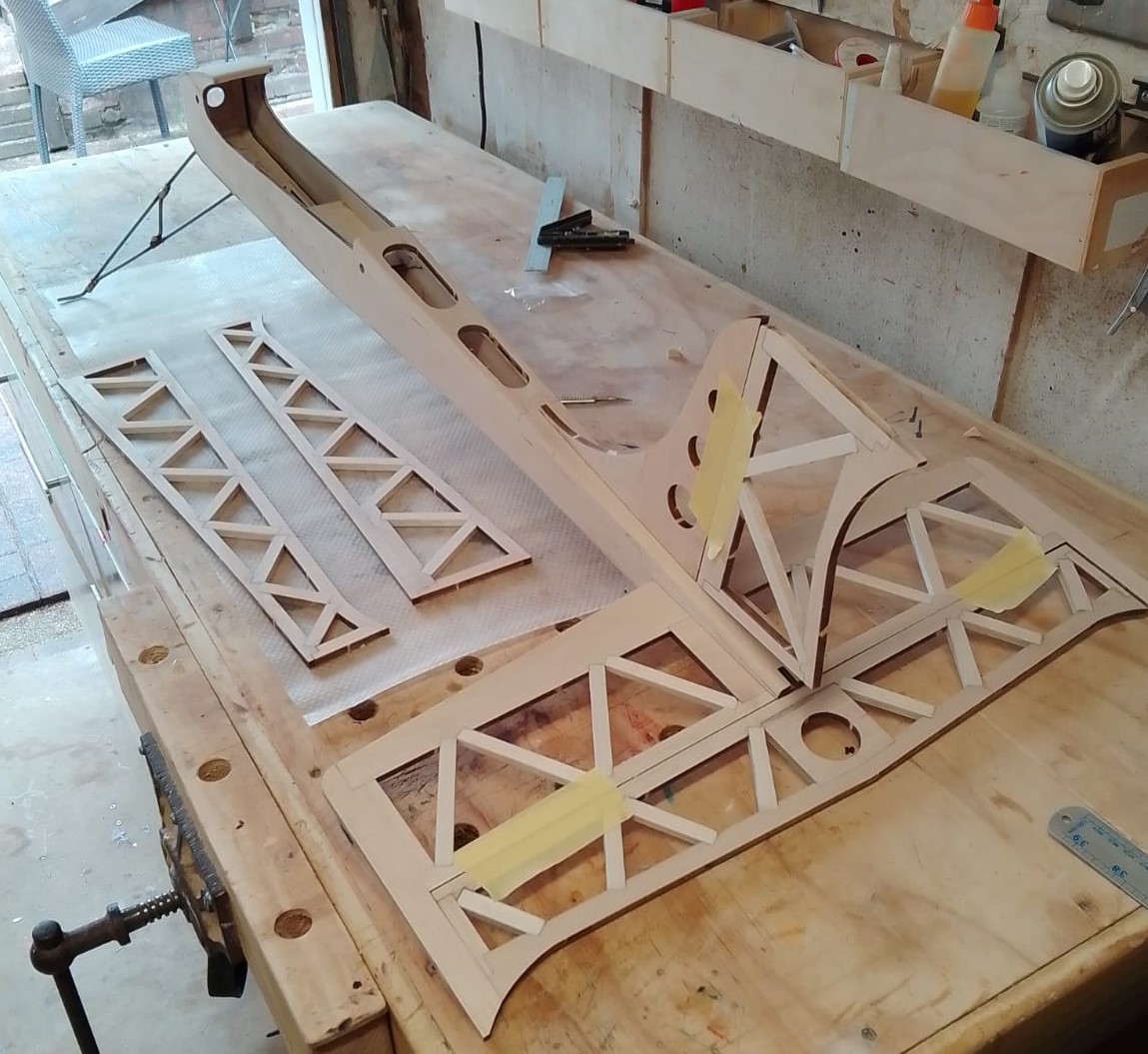 Next came the fuselage, this was a very straightforward tapered box that went together very easily, and made for a very rigid structure, however me being me, I can’t resist a mod or two. I don’t like band on wings so I decided to change to a bolt on fixing. I also prefer using self-tapping screws for fixing motors, so I added an extra 6mm ply firewall.
Next came the fuselage, this was a very straightforward tapered box that went together very easily, and made for a very rigid structure, however me being me, I can’t resist a mod or two. I don’t like band on wings so I decided to change to a bolt on fixing. I also prefer using self-tapping screws for fixing motors, so I added an extra 6mm ply firewall. 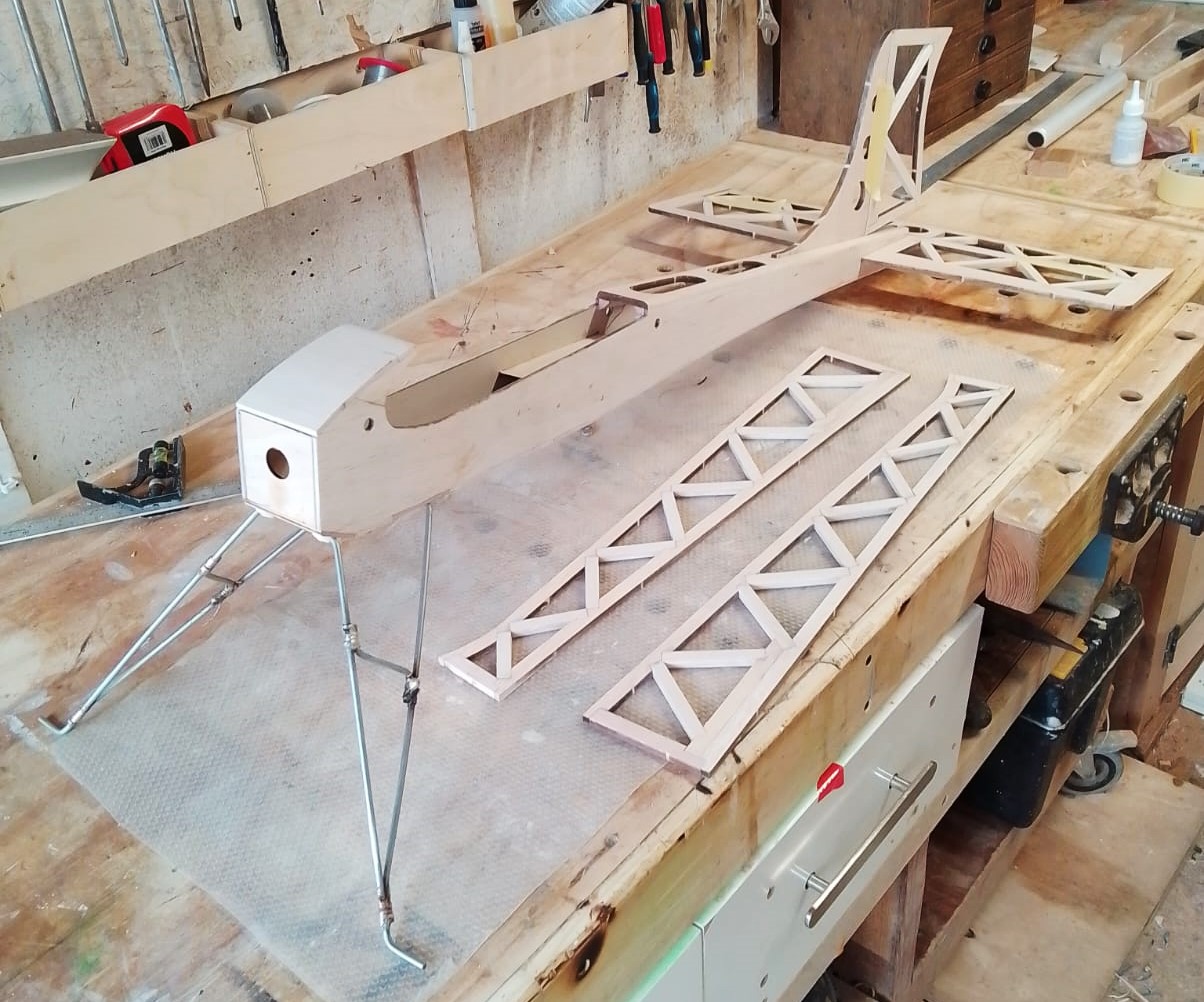 Next up was soldering the four parts of the undercarriage together, the instructions show this being done on a jig, but I preferred to do it with the parts fitted to the fuselage.
Next up was soldering the four parts of the undercarriage together, the instructions show this being done on a jig, but I preferred to do it with the parts fitted to the fuselage.
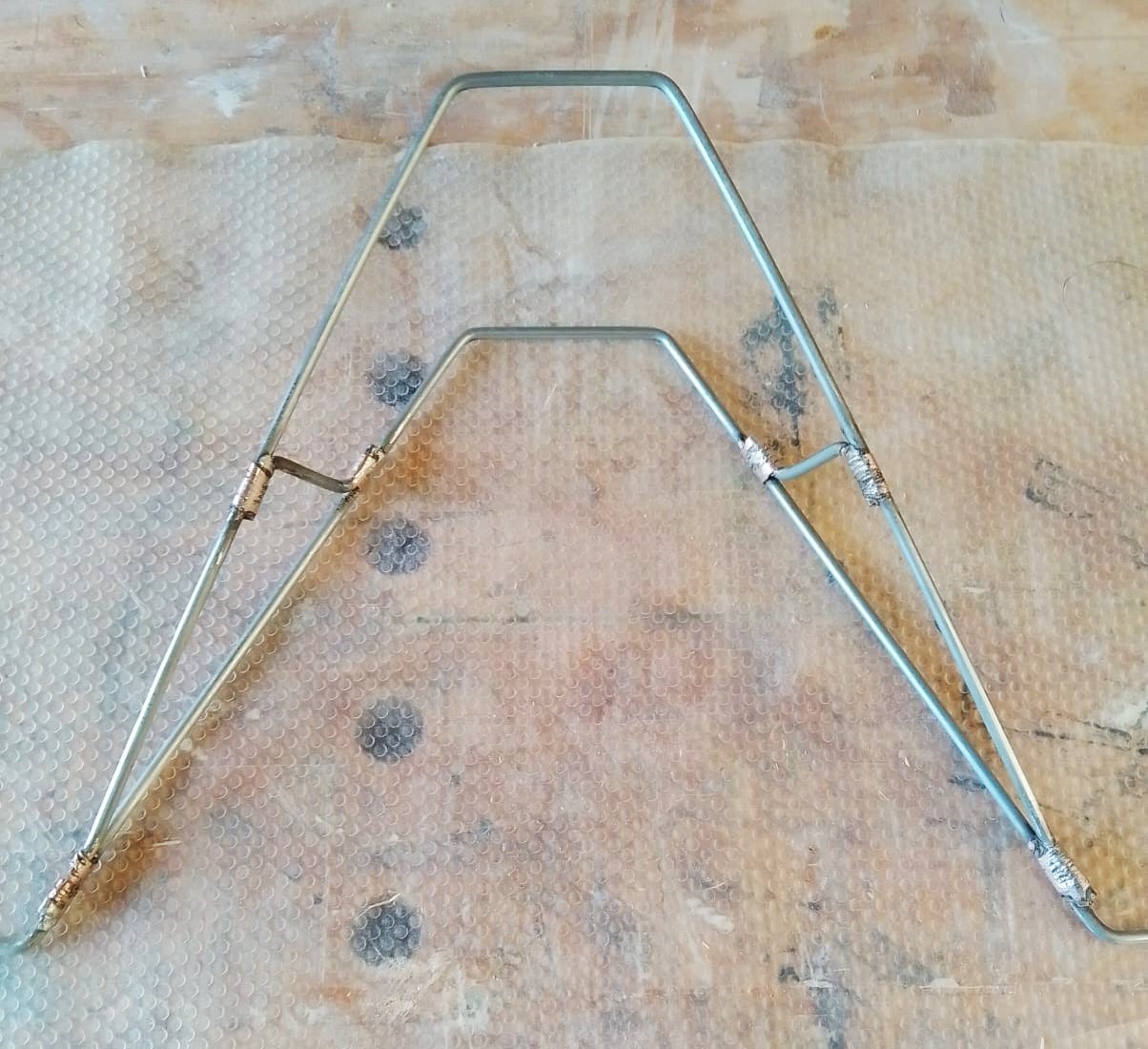 I now moved on to the wing assembly, and this is where things went a bit wrong!! With the wing pinned down, the structure was started in the normal order, see photos.
I now moved on to the wing assembly, and this is where things went a bit wrong!! With the wing pinned down, the structure was started in the normal order, see photos.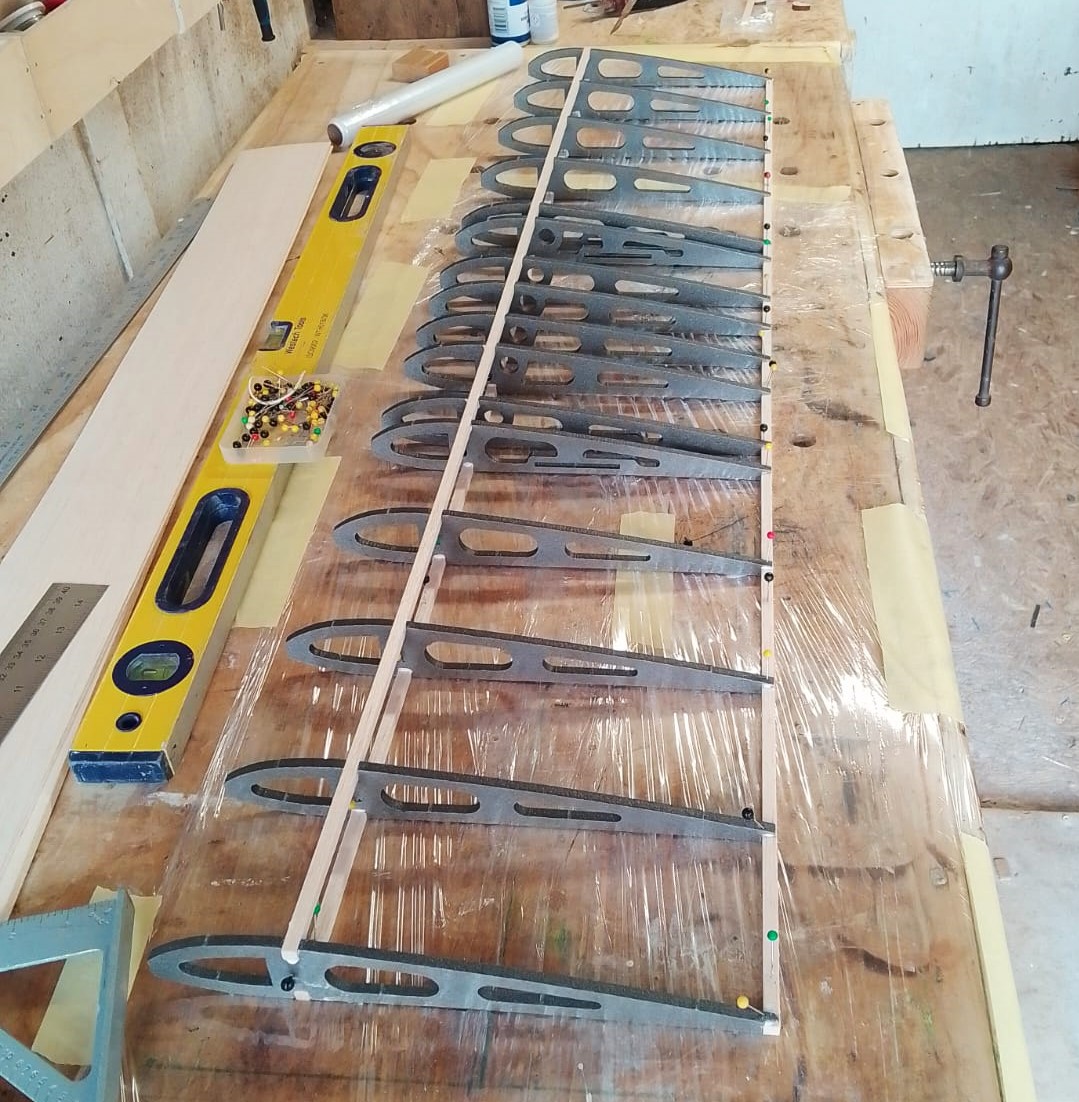
With all the ribs, and spars in place, the instructions give the dimensions for the webbing pieces to be fitted to the front edge of the top and bottom spars, I cut one and offered it up (see photo) and as you can see it was far too tall. All the rest were marked and cut in situ. Next the instructions tell you to chamfer the leading edge stock to follow the curve of the top and bottom of the aerofoil before fixing to the front of the ribs, this sounded a bit tricky so I decided to butt join it to the leading edge after the sheeting had been fitted.
Next the instructions tell you to chamfer the leading edge stock to follow the curve of the top and bottom of the aerofoil before fixing to the front of the ribs, this sounded a bit tricky so I decided to butt join it to the leading edge after the sheeting had been fitted.
 The instructions also tell you to cut the supplied 100mm sheet into 2 pieces one 80 mm wide for leading edge and the remaining 20mm piece for the trailing edge, which I did. However, if I had followed the leading edge instructions, the leading edge sheet would be too narrow. The next issue I faced was that the Depron ribs would not hold the pins for fixing the leading-edge sheet even after wetting. With the glue already applied, I had to rely on a lot of house bricks, and a straight edge to hold it in place.
The instructions also tell you to cut the supplied 100mm sheet into 2 pieces one 80 mm wide for leading edge and the remaining 20mm piece for the trailing edge, which I did. However, if I had followed the leading edge instructions, the leading edge sheet would be too narrow. The next issue I faced was that the Depron ribs would not hold the pins for fixing the leading-edge sheet even after wetting. With the glue already applied, I had to rely on a lot of house bricks, and a straight edge to hold it in place.
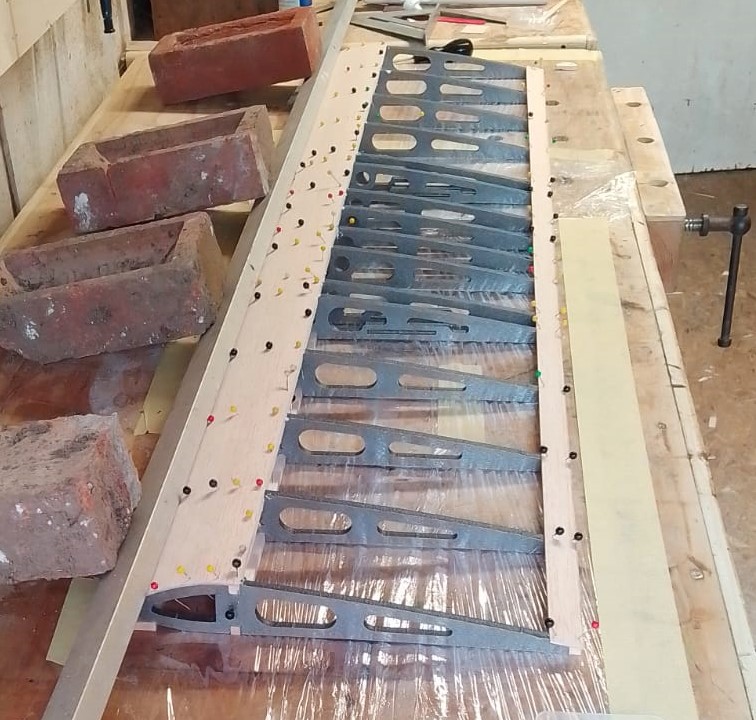
 All the top sheeting was completed, but when it came to fitting the rib capping the material supplied was supposed to be the same thickness as the rest of the sheet but it was visibly thinner which made sanding more difficult than it should have been.
All the top sheeting was completed, but when it came to fitting the rib capping the material supplied was supposed to be the same thickness as the rest of the sheet but it was visibly thinner which made sanding more difficult than it should have been.
The wing was now turned over, pinned back onto the bench and all the bottom sheeting added. With all the glue dry and the wing off the bench I felt that the trailing edge seemed very unstable, with poor torsional strength, and over the next few days it developed a very visible bow (see photo).
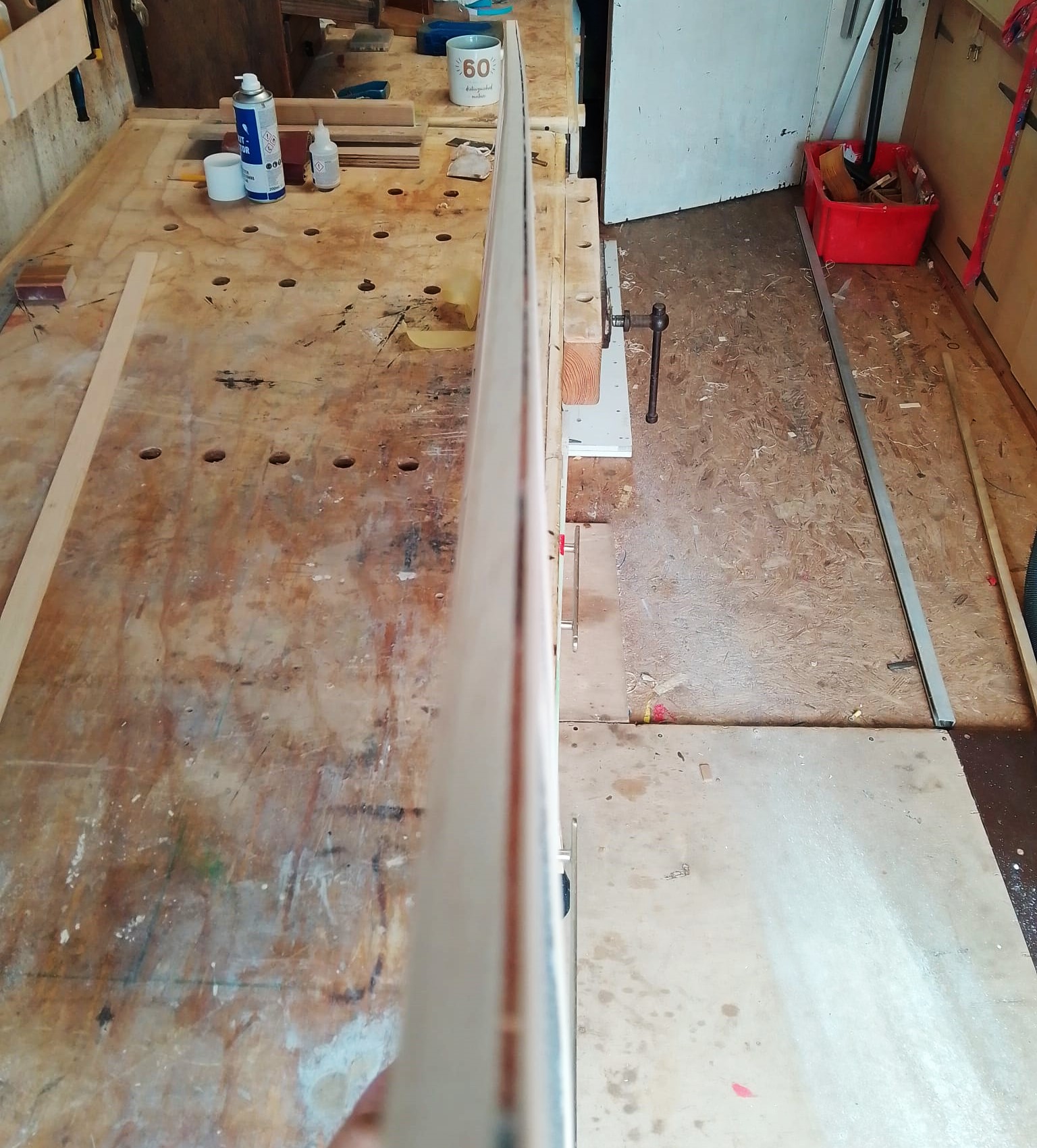 So it was all pinned down again, webbing added to the front of the trailing edge sheeting, and a 6mm x 4mm extra trailing edge fitted, which seemed to sort things out.
So it was all pinned down again, webbing added to the front of the trailing edge sheeting, and a 6mm x 4mm extra trailing edge fitted, which seemed to sort things out. 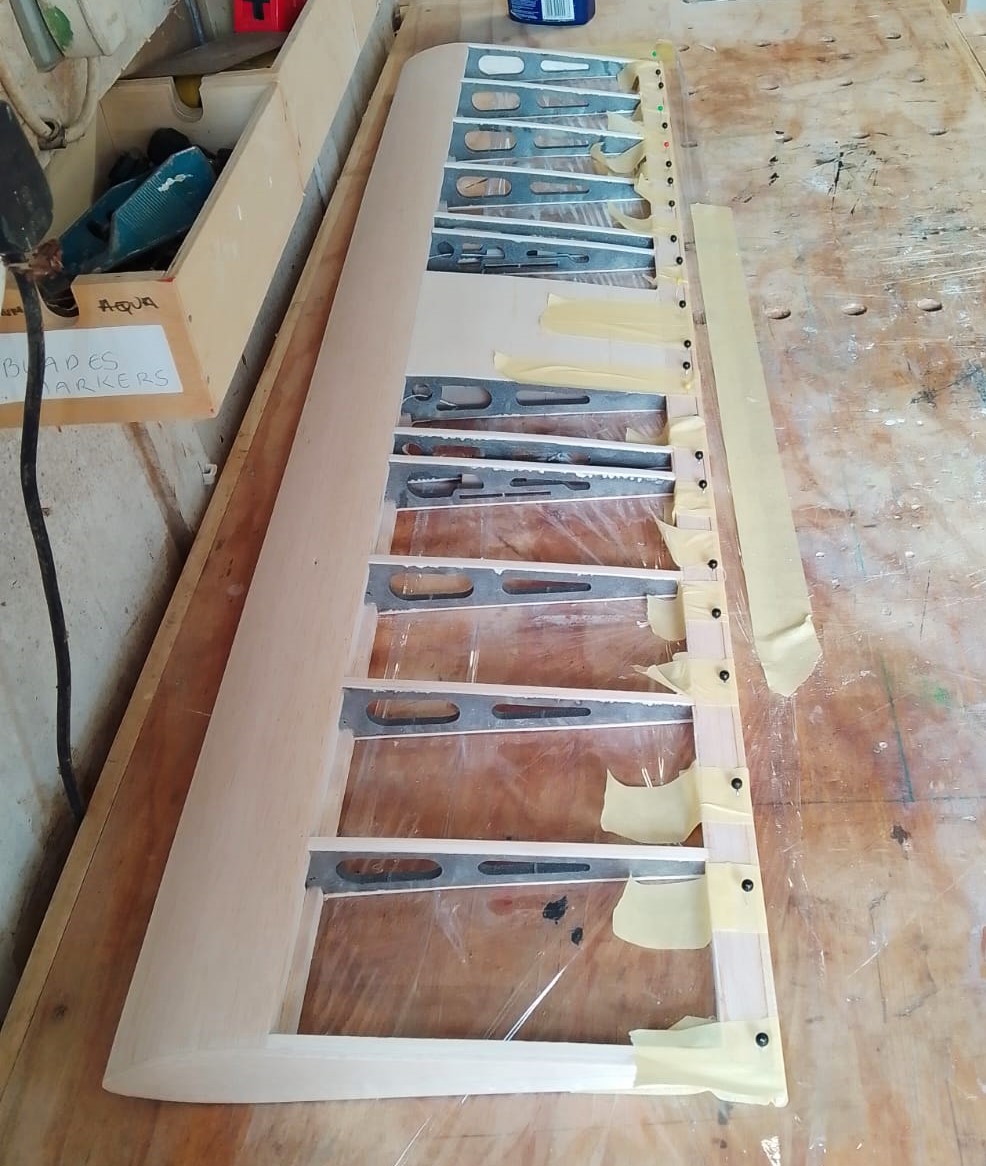 My next concern was the fixing of the large wing tips, I was not happy with fixing them directly to the Depron ribs so I added some thin balsa sheet, and braces to make a much stronger assembly (see photo).
My next concern was the fixing of the large wing tips, I was not happy with fixing them directly to the Depron ribs so I added some thin balsa sheet, and braces to make a much stronger assembly (see photo).
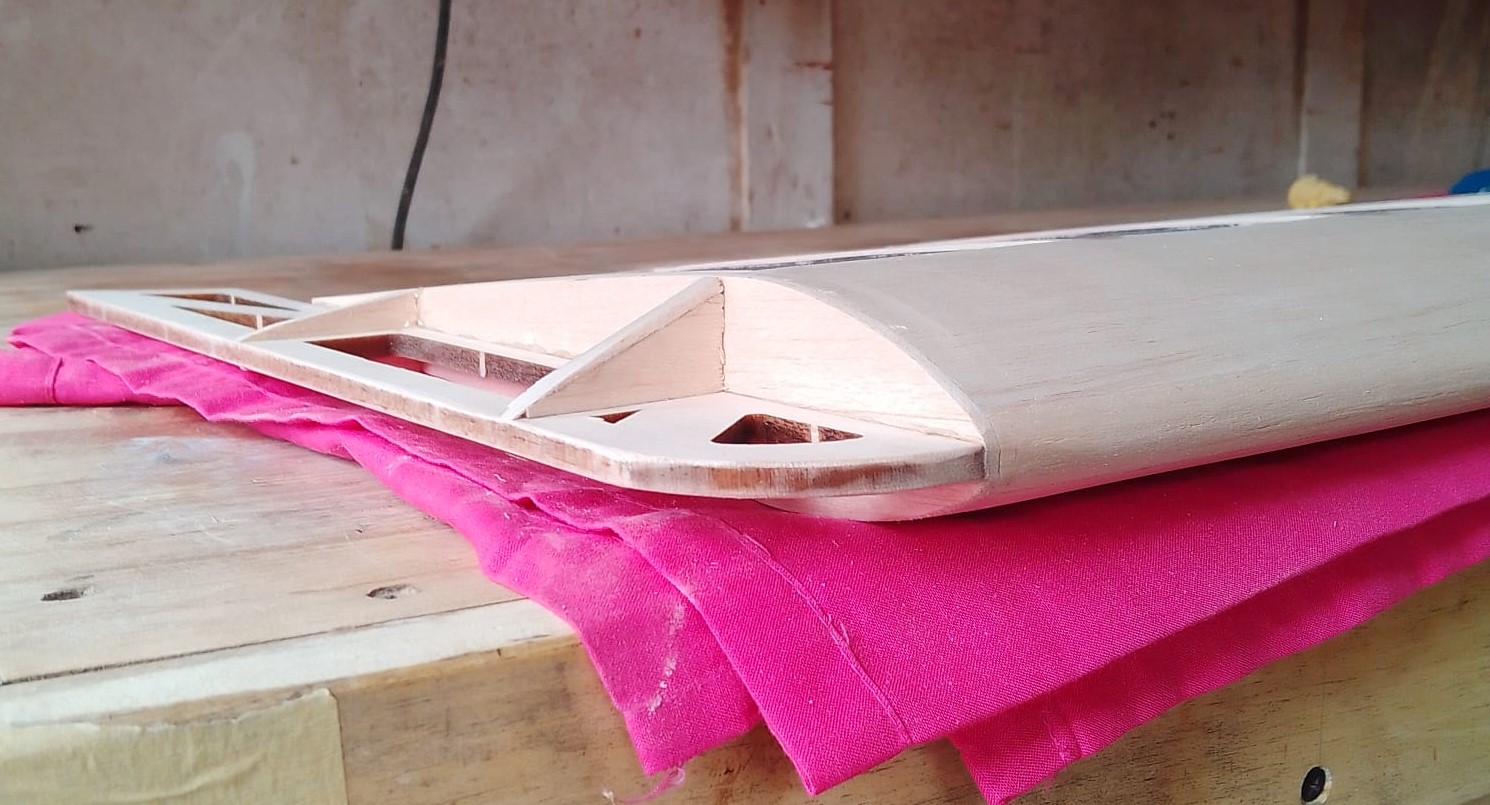 With all the components completed I did a dry assembly to check alignments etc. The next issue to come to light was the poor fit of the leading edge in the fuselage (see photo) which had me very puzzled as all the parts were laser cut!
With all the components completed I did a dry assembly to check alignments etc. The next issue to come to light was the poor fit of the leading edge in the fuselage (see photo) which had me very puzzled as all the parts were laser cut!
 Plus, the wing has a small under camber which was not reflected on the wing seat. When I build any model I always check the wing and tail incidences with a basic meter, on this occasion it showed the tail was set at a positive angle when compared to the wing! A few hours of filling, sanding, and reshaping resolved all of the above issues.
Plus, the wing has a small under camber which was not reflected on the wing seat. When I build any model I always check the wing and tail incidences with a basic meter, on this occasion it showed the tail was set at a positive angle when compared to the wing! A few hours of filling, sanding, and reshaping resolved all of the above issues.
 The rest of the build, covering, and gear installation was straightforward, but I still changed a few things. The instructions call for the ESC to be fitted outside of the fuselage, between the undercarriage legs, but I wanted it inside, which was easier said than done. All surfaces are top hinged, elevator control is via a closed loop, instead of a pushrod.
The rest of the build, covering, and gear installation was straightforward, but I still changed a few things. The instructions call for the ESC to be fitted outside of the fuselage, between the undercarriage legs, but I wanted it inside, which was easier said than done. All surfaces are top hinged, elevator control is via a closed loop, instead of a pushrod.

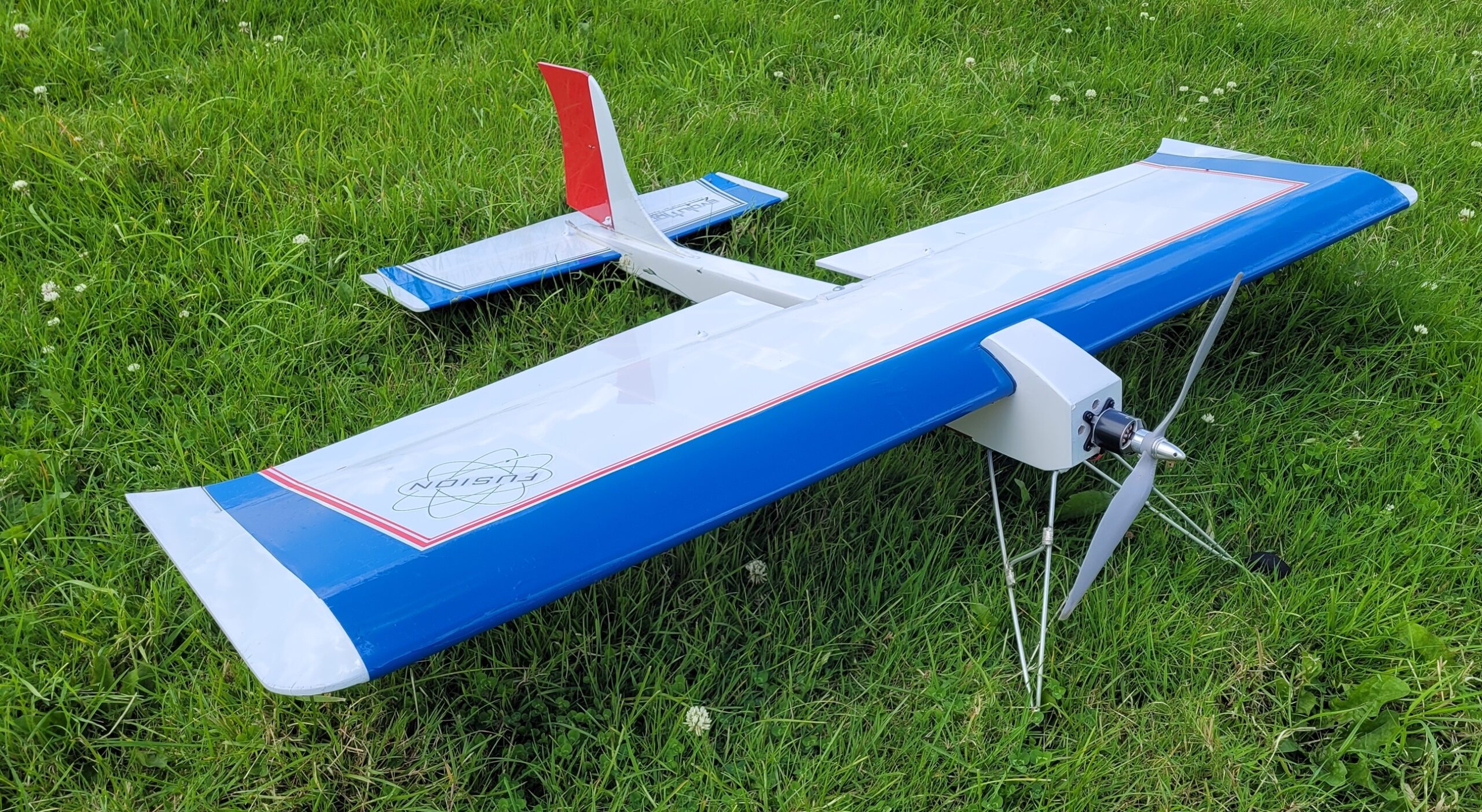
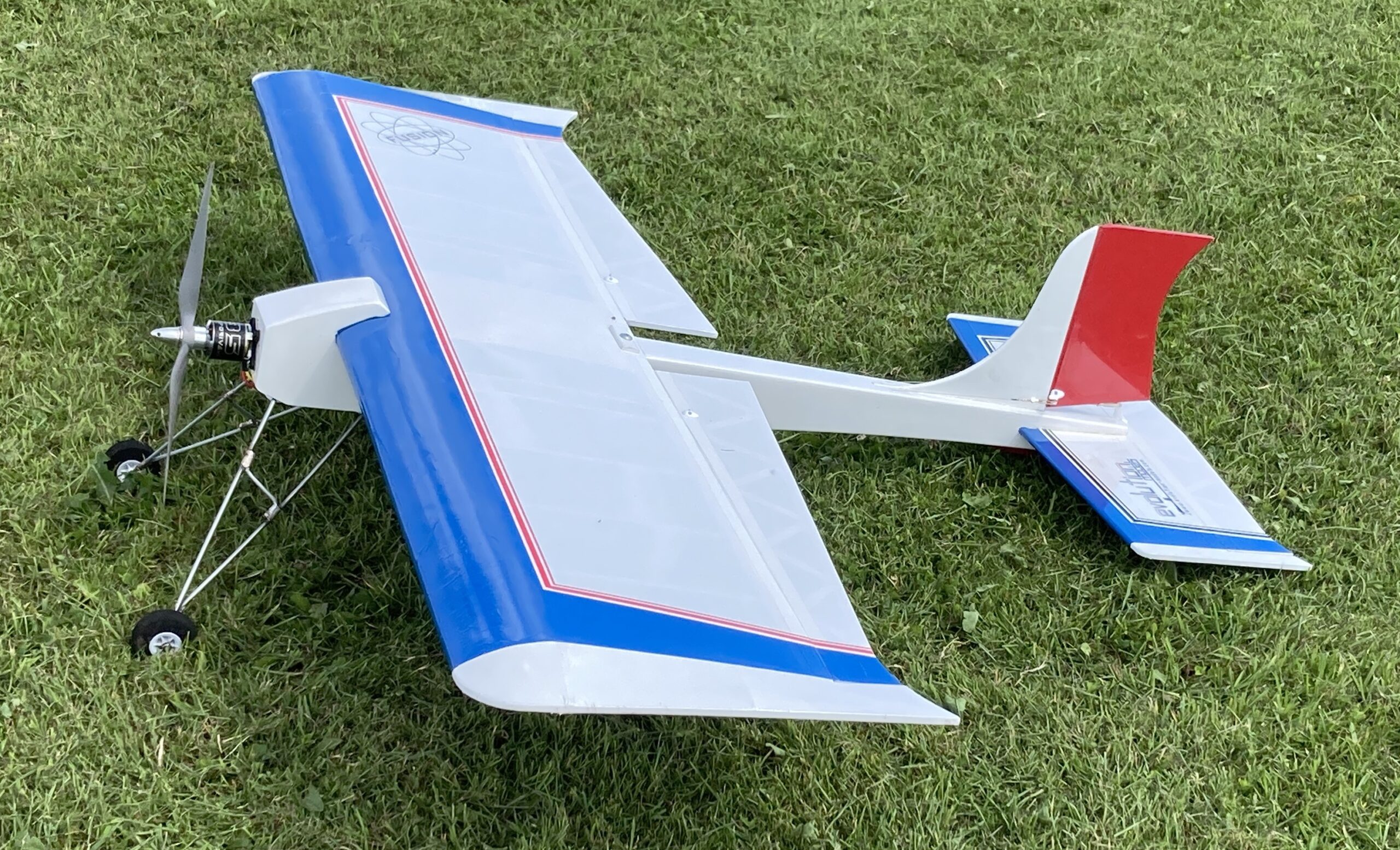
 Finally, balancing the model at the recommended starting position of 25 mm behind the main spar took a huge amount of lead, however, the designers say their display models balance at 50% of the chord, this would need far less lead, but was not something I wanted to risk. As I said at the beginning of this drivel, I have now flown the model, and I am happy to report, it’s great, it needed no trim and I am very happy with the CG.
Finally, balancing the model at the recommended starting position of 25 mm behind the main spar took a huge amount of lead, however, the designers say their display models balance at 50% of the chord, this would need far less lead, but was not something I wanted to risk. As I said at the beginning of this drivel, I have now flown the model, and I am happy to report, it’s great, it needed no trim and I am very happy with the CG.
Thanks for that very comprehensive report 1066, I can happily agree that the Fusion flies brilliantly and performs exactly as a FunFly model should. Apparently 1066 thinks the Fusion is ugly so he calls his Fugly. I’m assured this is short for Flipping Ugly…
Last year Dougal Entendre smashed the nose of his Max Thrust Aggressor electric glider. I won’t embarrass him by going into details, let’s just say it involved a fast low pass and a large bush. Dougal ordered a replacement fuselage but kept the damaged one although it seemed unlikely he would ever need a spare back half of a fuselage, after all, who manages to break the back half but not damage the nose? Well it turns out that Dougal does! He appeared to have a radio problem and the Aggressor crashed again. It must have hit the ground with one wingtip as the nose was undamaged but the rear fuselage broke in half.
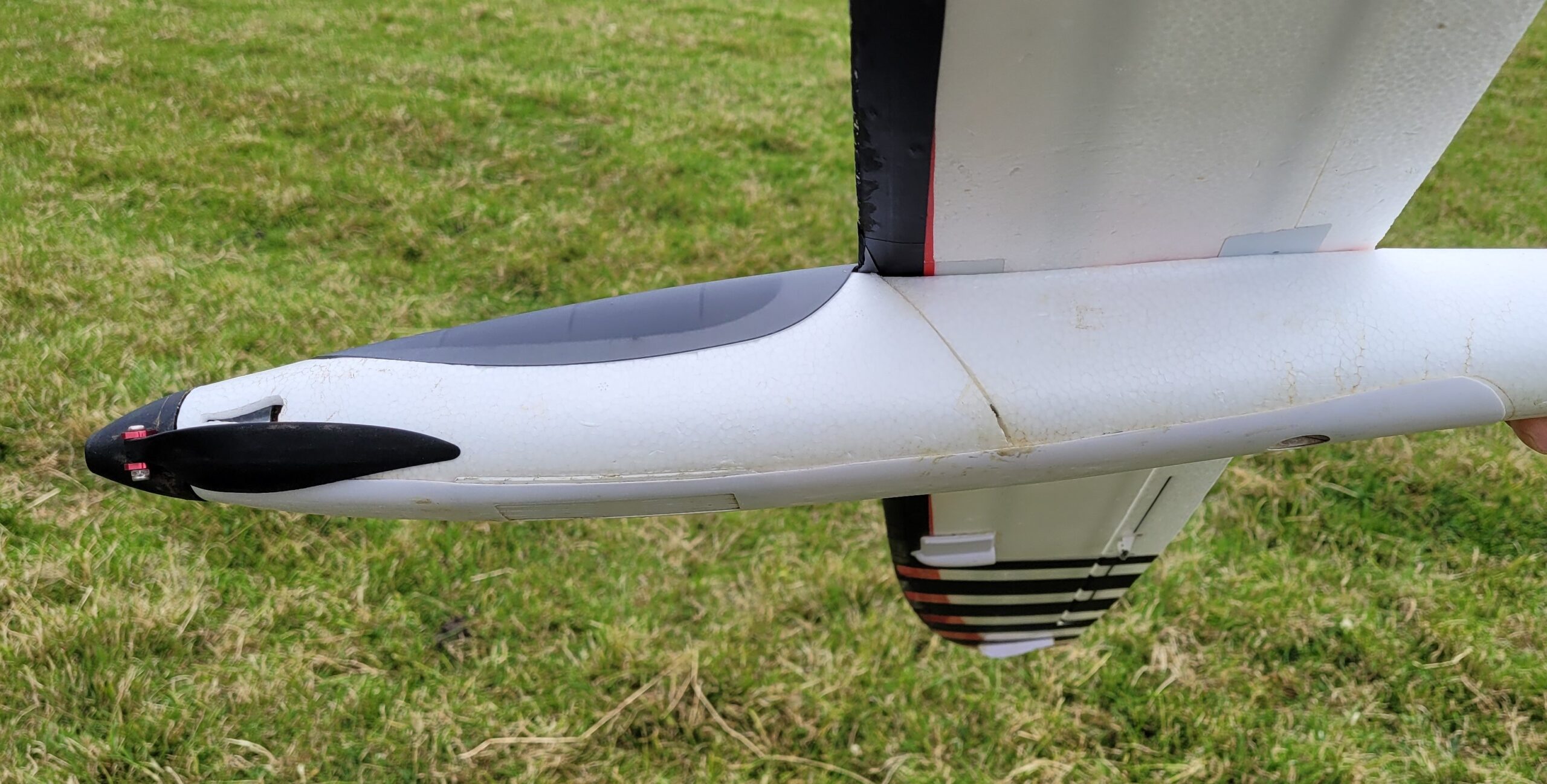 After a minor repair to the wingtip Dougal got out his saw and was able to graft the old fuselage rear end to the newer and undamaged nose. He’s made an excellent job of the repair and the Aggressor is flying beautifully again with no trim required.
After a minor repair to the wingtip Dougal got out his saw and was able to graft the old fuselage rear end to the newer and undamaged nose. He’s made an excellent job of the repair and the Aggressor is flying beautifully again with no trim required.
Staying on the subject of repairs, I think Dwayne Pipe might struggle to repair his Gnat. 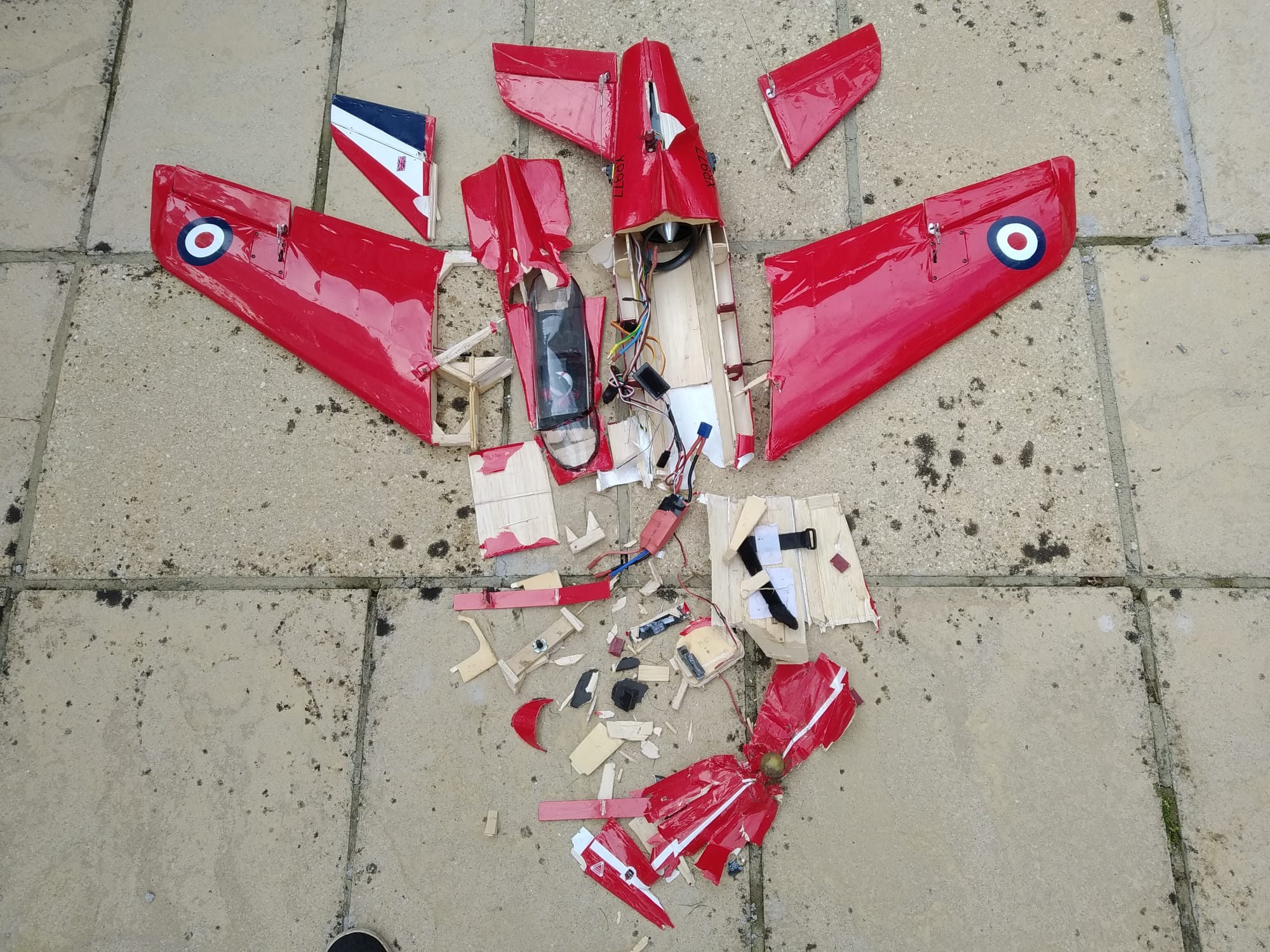 The flight was going really well until Dwayne got disorientated after rolling out from a spell of inverted flight. Sadly I don’t think it’s going to buff out this time Dwayne!
The flight was going really well until Dwayne got disorientated after rolling out from a spell of inverted flight. Sadly I don’t think it’s going to buff out this time Dwayne!
Captain Slow has found a model that suits his flying style perfectly, a vintage Junior 60.
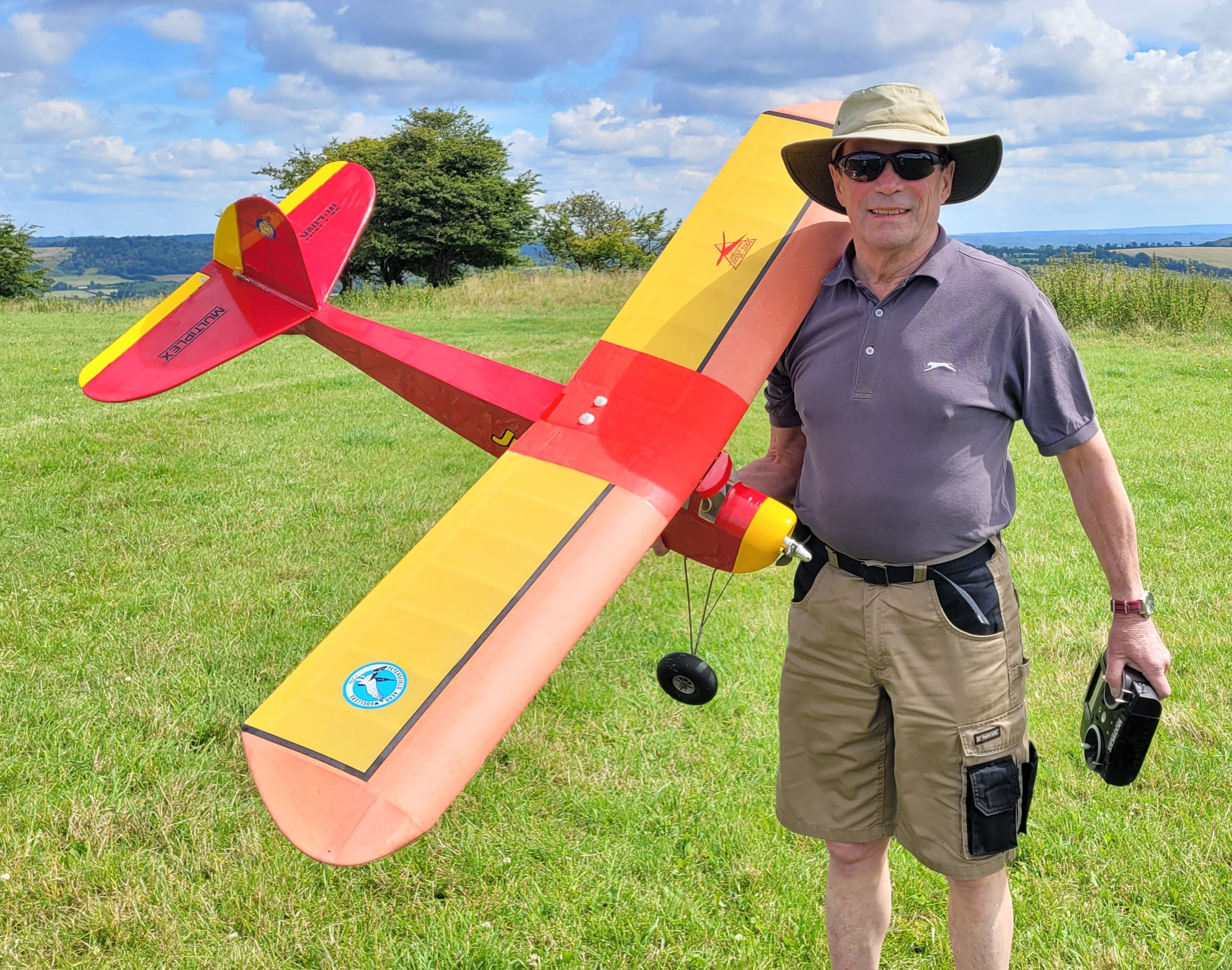 It was built by the late Chris P Bacon (Nigel Baker) and Captain Slow bought it when Nigel’s models were sold off following his passing in April last year. Captain Slow did some minor repairs to the tail and fitted his own receiver but everything else is as it came.
It was built by the late Chris P Bacon (Nigel Baker) and Captain Slow bought it when Nigel’s models were sold off following his passing in April last year. Captain Slow did some minor repairs to the tail and fitted his own receiver but everything else is as it came.
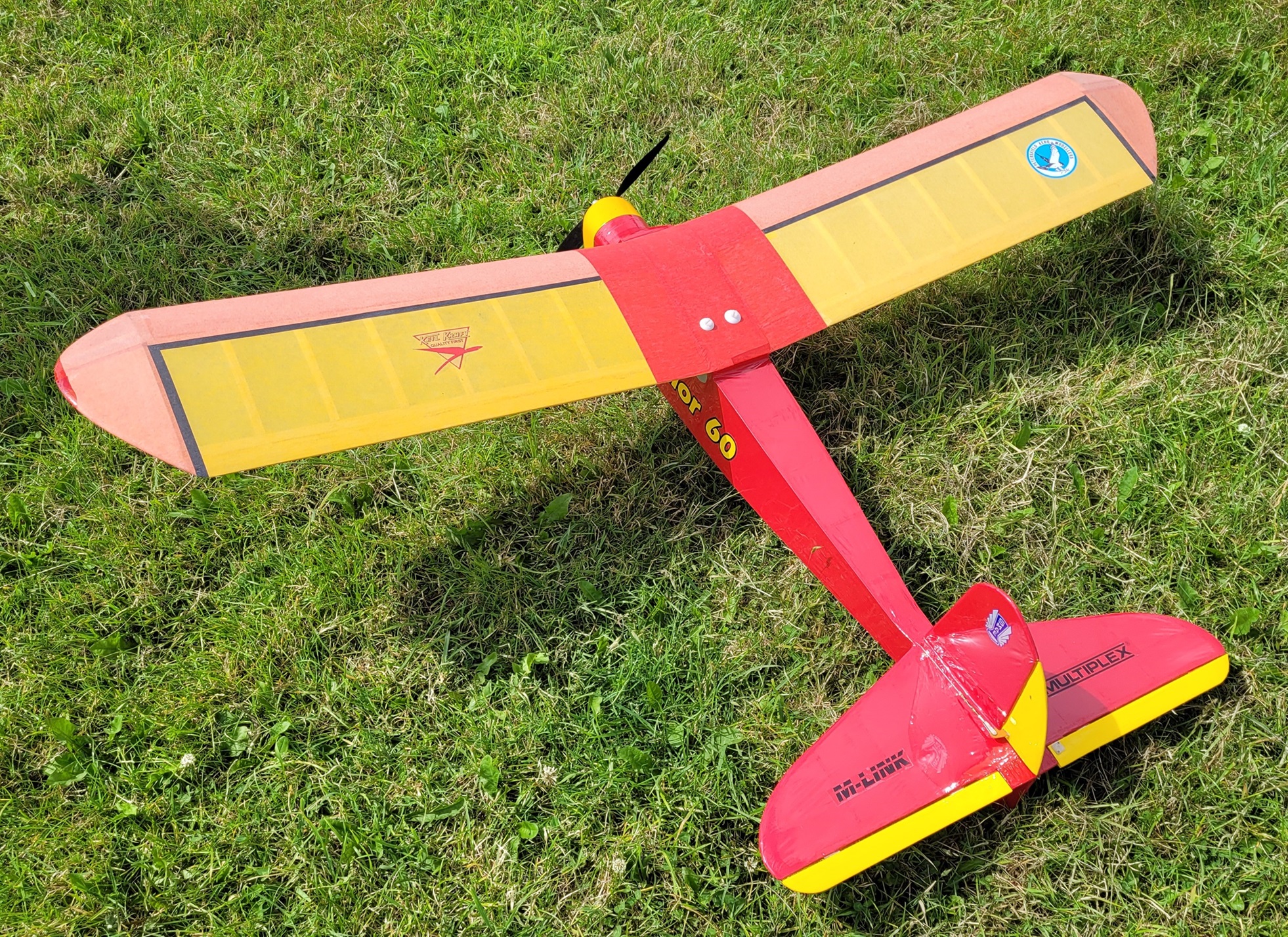
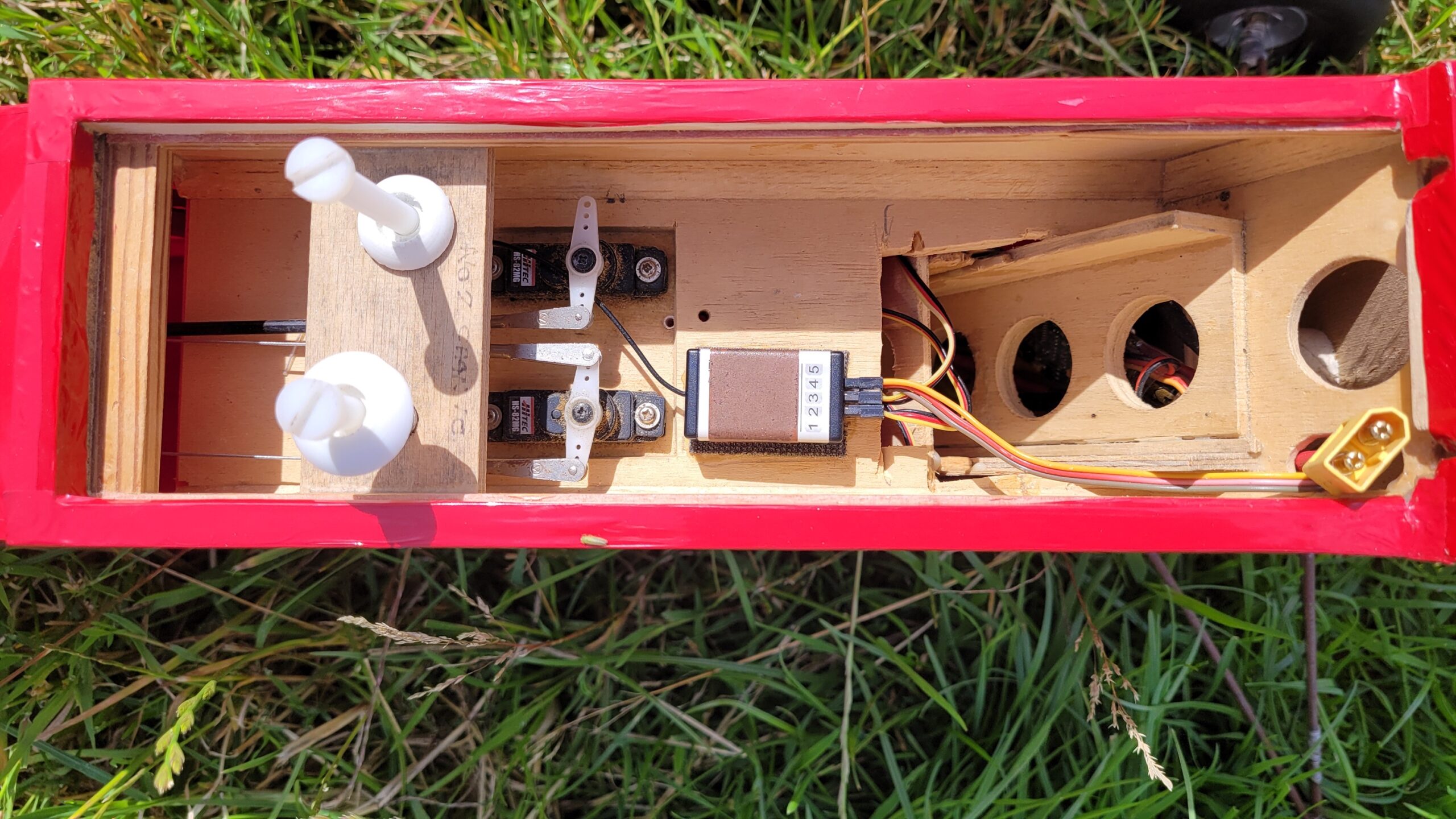 The Junior 60 has its origins back in 1946 when it was designed as a free-flight model by Albert Hatfull. This one was built from a Ben Buckle kit and is of course electric powered.
The Junior 60 has its origins back in 1946 when it was designed as a free-flight model by Albert Hatfull. This one was built from a Ben Buckle kit and is of course electric powered.
 The model flew beautifully and slowly, which is exactly what Captain Slow wanted, and the only problem he had was getting it down, the Junior just wanted to float along forever!
The model flew beautifully and slowly, which is exactly what Captain Slow wanted, and the only problem he had was getting it down, the Junior just wanted to float along forever!
Having recently sold me his XFly T-7A Red Hawk because it was a bit too much of a handful for him Woody has replaced it with an XFly F-22 Raptor. Hmm…
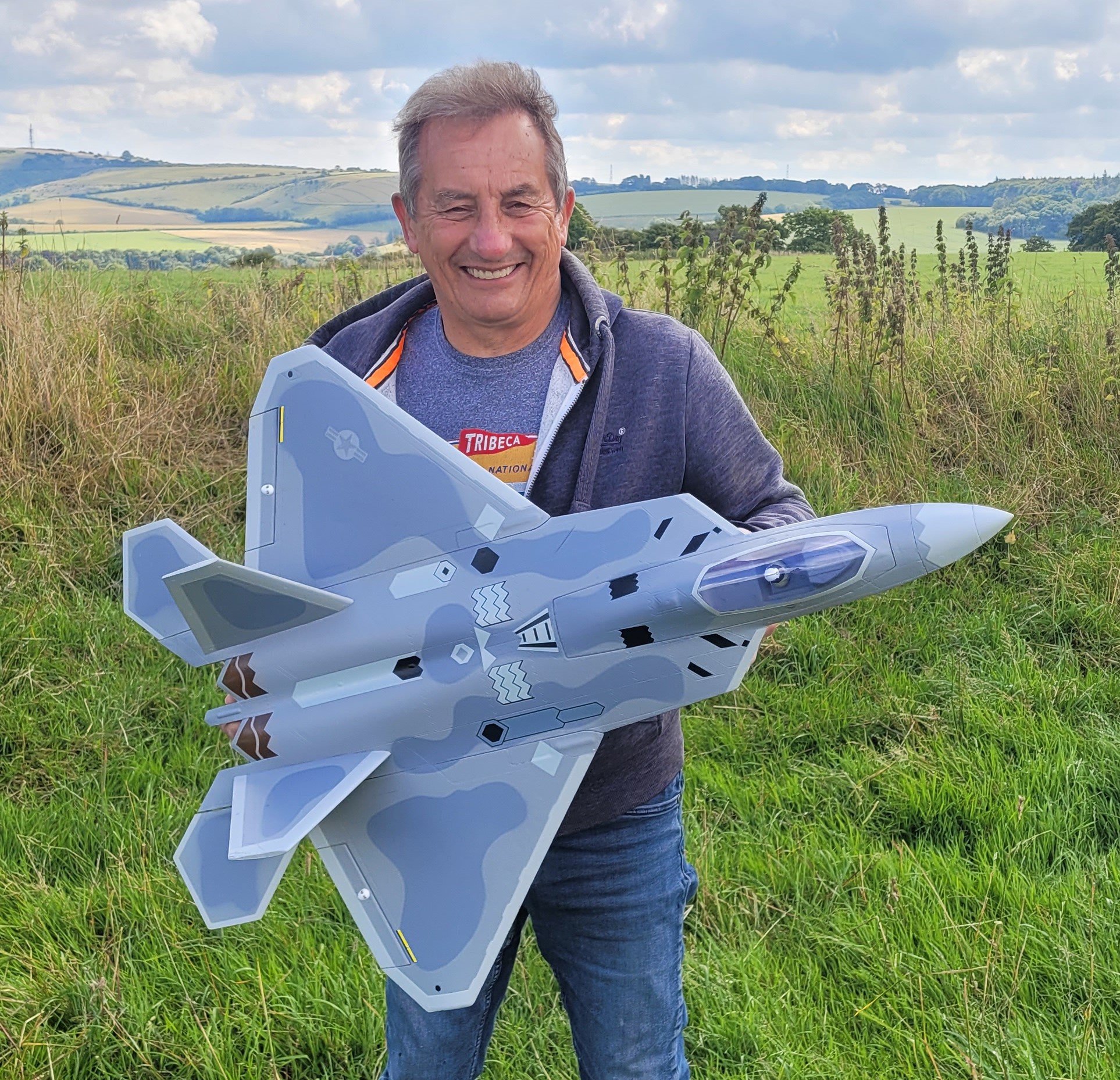
 We advised against buying the Raptor but Woody reckoned it should be easier to fly than the Red Hawk because it has a larger wing area and a lower wing loading but the XFly specs say the Raptor has a smaller wing area and a higher wing loading. Another hmm…
We advised against buying the Raptor but Woody reckoned it should be easier to fly than the Red Hawk because it has a larger wing area and a lower wing loading but the XFly specs say the Raptor has a smaller wing area and a higher wing loading. Another hmm…
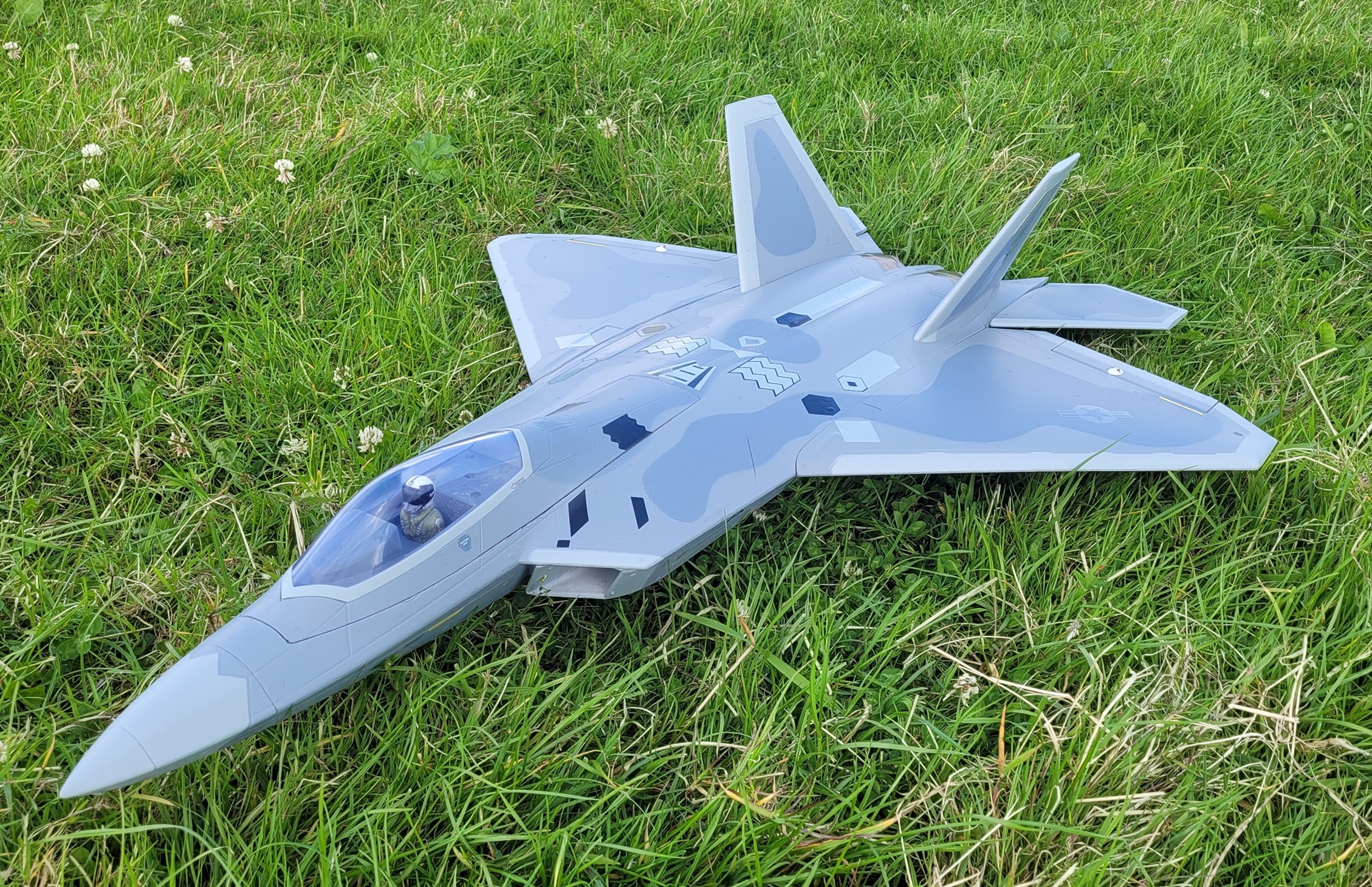 The Raptor has a wingspan of 702mm and weighs around 950g with a 4 cell lipo. It’s powered by two 12 bladed 40mm fans each of which is run by a 1413 5000KV motor and has its own 20A speed controller. The gyro wasn’t operating in the correct direction so rather than mess around with the settings at the field the first three flights were done with the gyro switched off and they were all rather ‘interesting’ going away from a hand launch.
The Raptor has a wingspan of 702mm and weighs around 950g with a 4 cell lipo. It’s powered by two 12 bladed 40mm fans each of which is run by a 1413 5000KV motor and has its own 20A speed controller. The gyro wasn’t operating in the correct direction so rather than mess around with the settings at the field the first three flights were done with the gyro switched off and they were all rather ‘interesting’ going away from a hand launch.
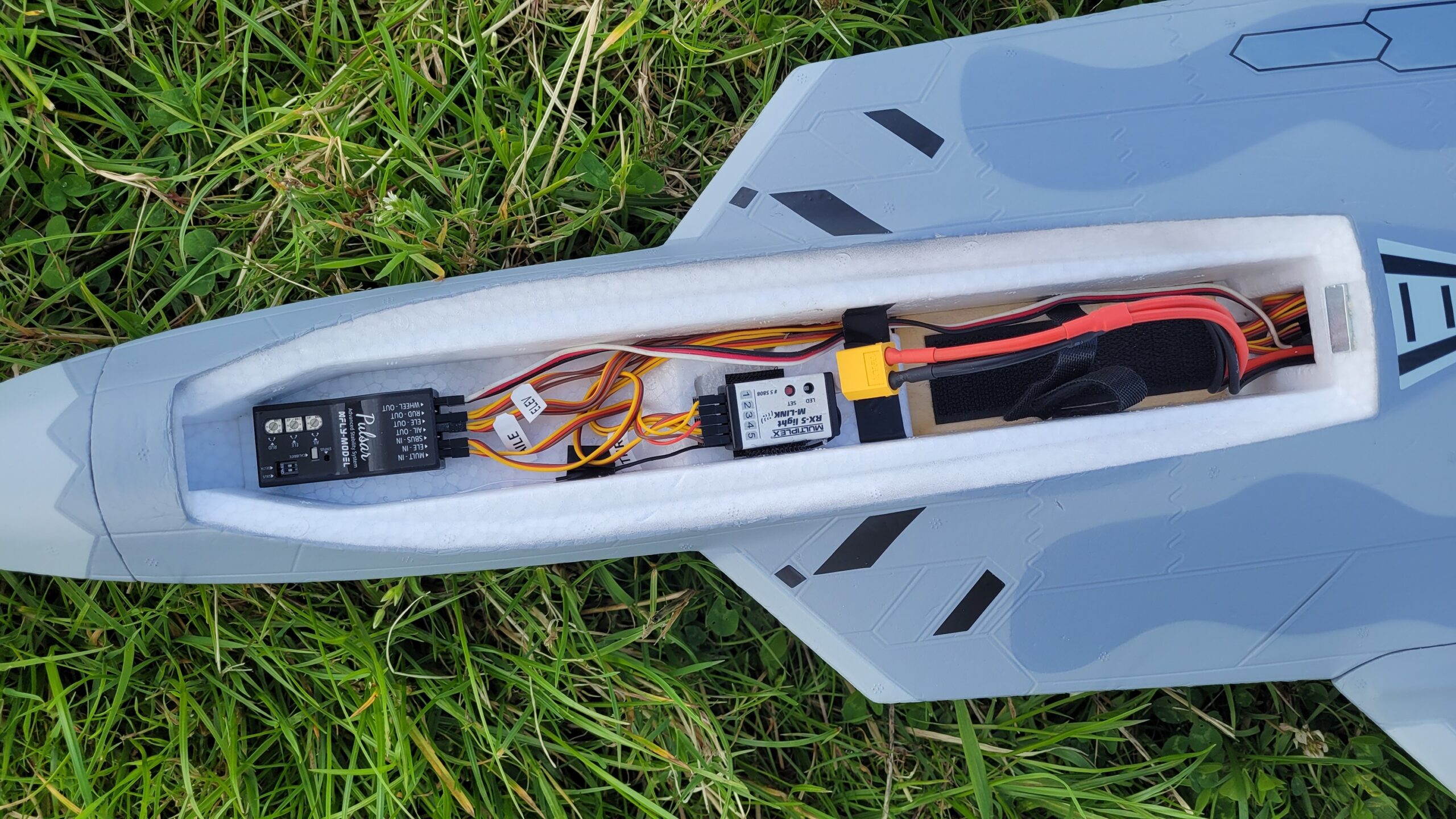 Once airborne the Raptor flew well, it just seems to need a fair heave to get it flying. Woody had sorted the gyro setting out by the next session and it was launched with the gyro set in the damping mode and it’s gone away from every launch with no further problems. I’m not sure that’s because the gyro is doing its stuff or the launchers have got better at throwing it. You can see the first launch in this month’s video and you’ll see that it was tricky but that the Raptor flies very nicely once it’s got a bit of speed.
Once airborne the Raptor flew well, it just seems to need a fair heave to get it flying. Woody had sorted the gyro setting out by the next session and it was launched with the gyro set in the damping mode and it’s gone away from every launch with no further problems. I’m not sure that’s because the gyro is doing its stuff or the launchers have got better at throwing it. You can see the first launch in this month’s video and you’ll see that it was tricky but that the Raptor flies very nicely once it’s got a bit of speed.
As I mentioned earlier the annual Chuck Glider competition was held in July, ably run by Dwayne Pipe. Here’s Dwayne’s report: The annual chuck glider competition was held this month. Instead of our new flying field, we held it on the playing fields at Buriton as we didn’t want any chuck gliders to get carried away in the wind and end up in East Meon. 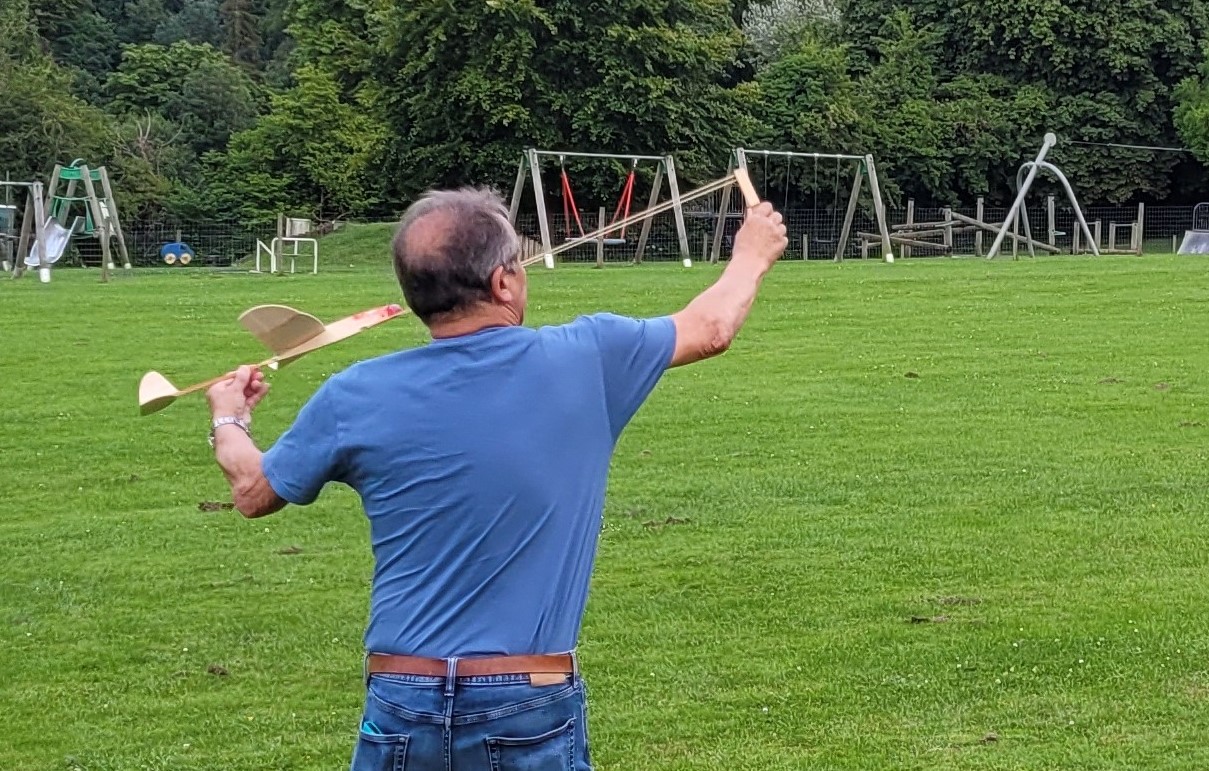
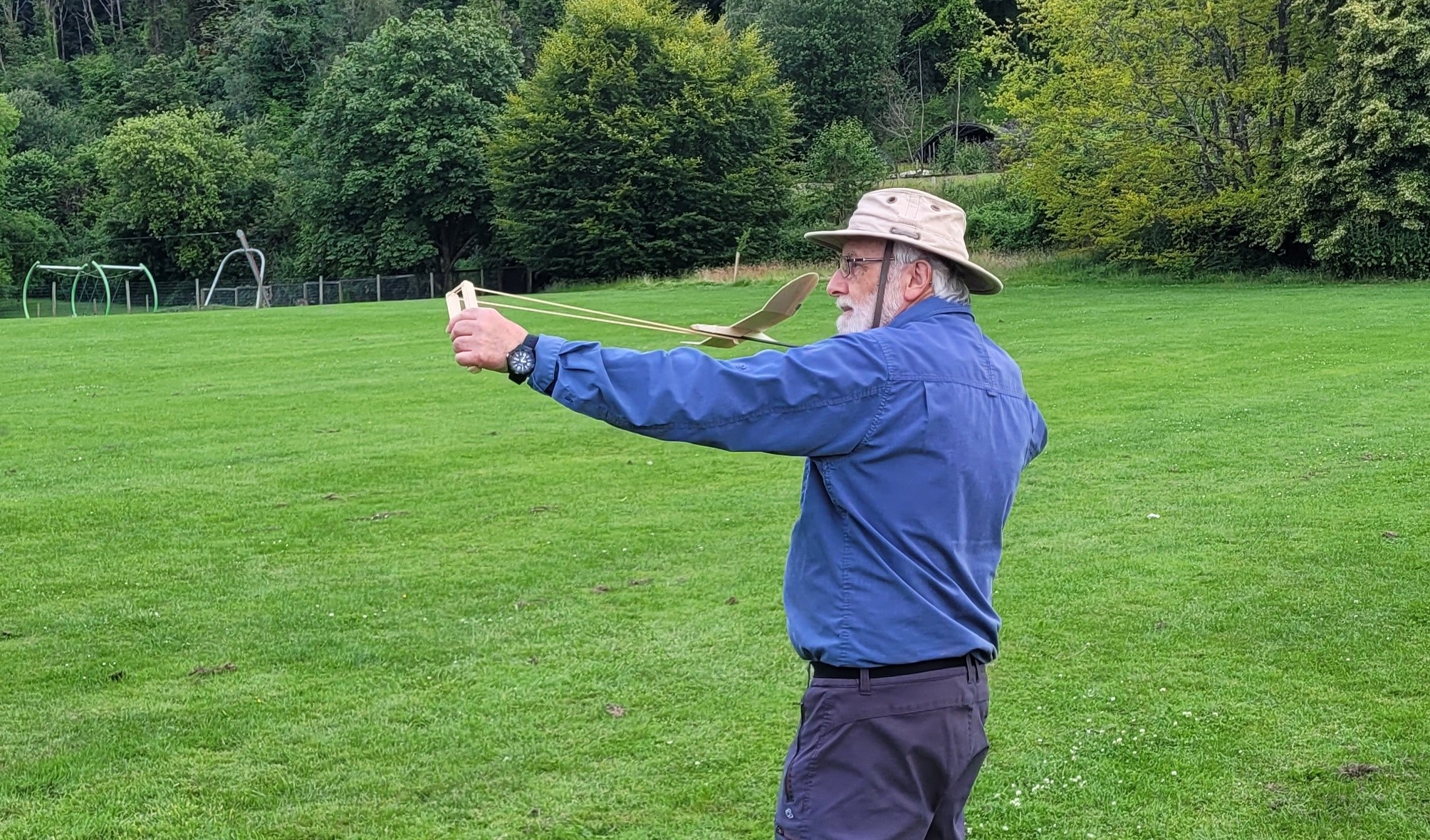
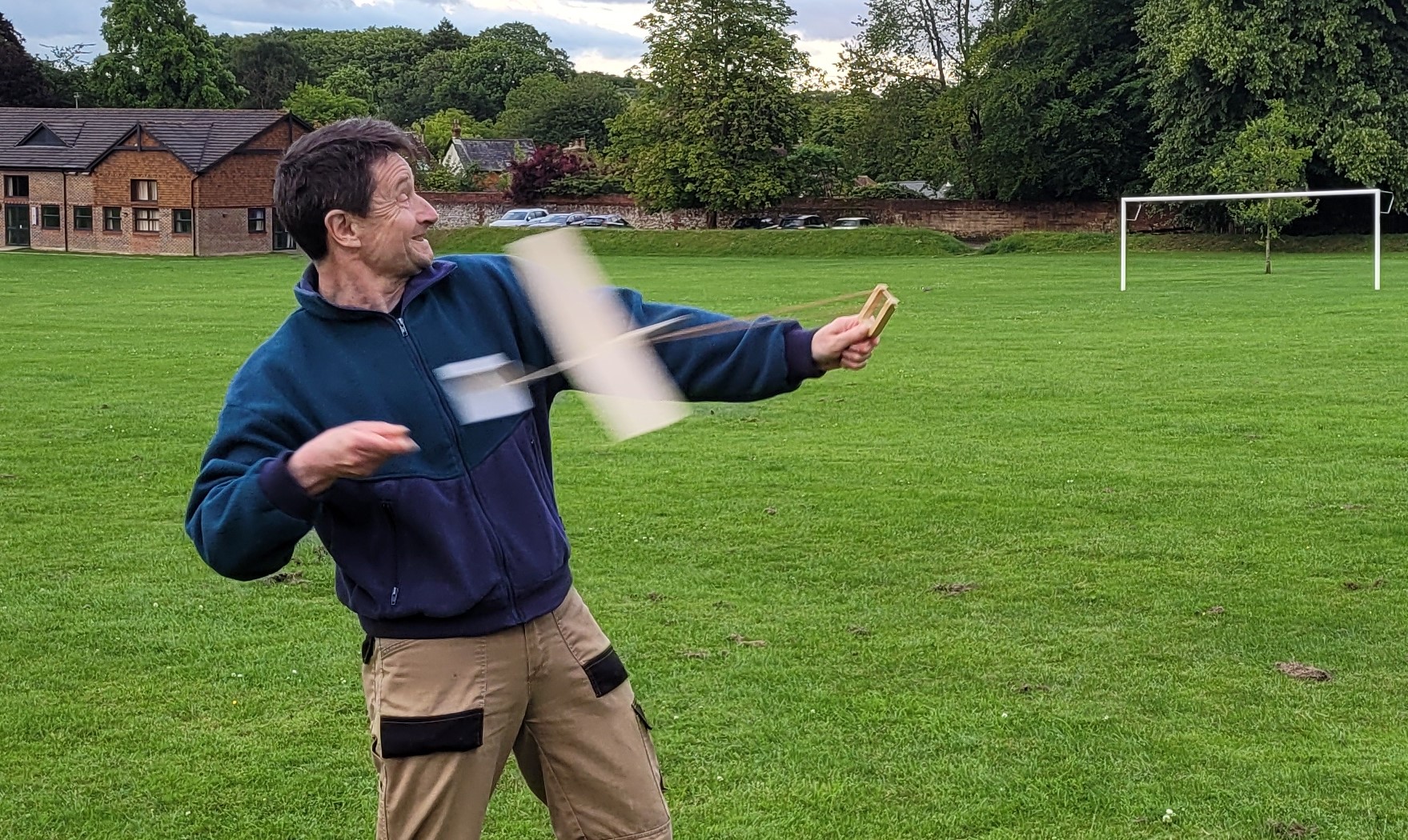 In the event, the conditions were perfect, and we had nine people turn up and eight take part in the competitions. In the standard Chuck Glider category, it will come as no surprise to learn that Colin Cowplain won with a significant lead over everybody else.
In the event, the conditions were perfect, and we had nine people turn up and eight take part in the competitions. In the standard Chuck Glider category, it will come as no surprise to learn that Colin Cowplain won with a significant lead over everybody else. 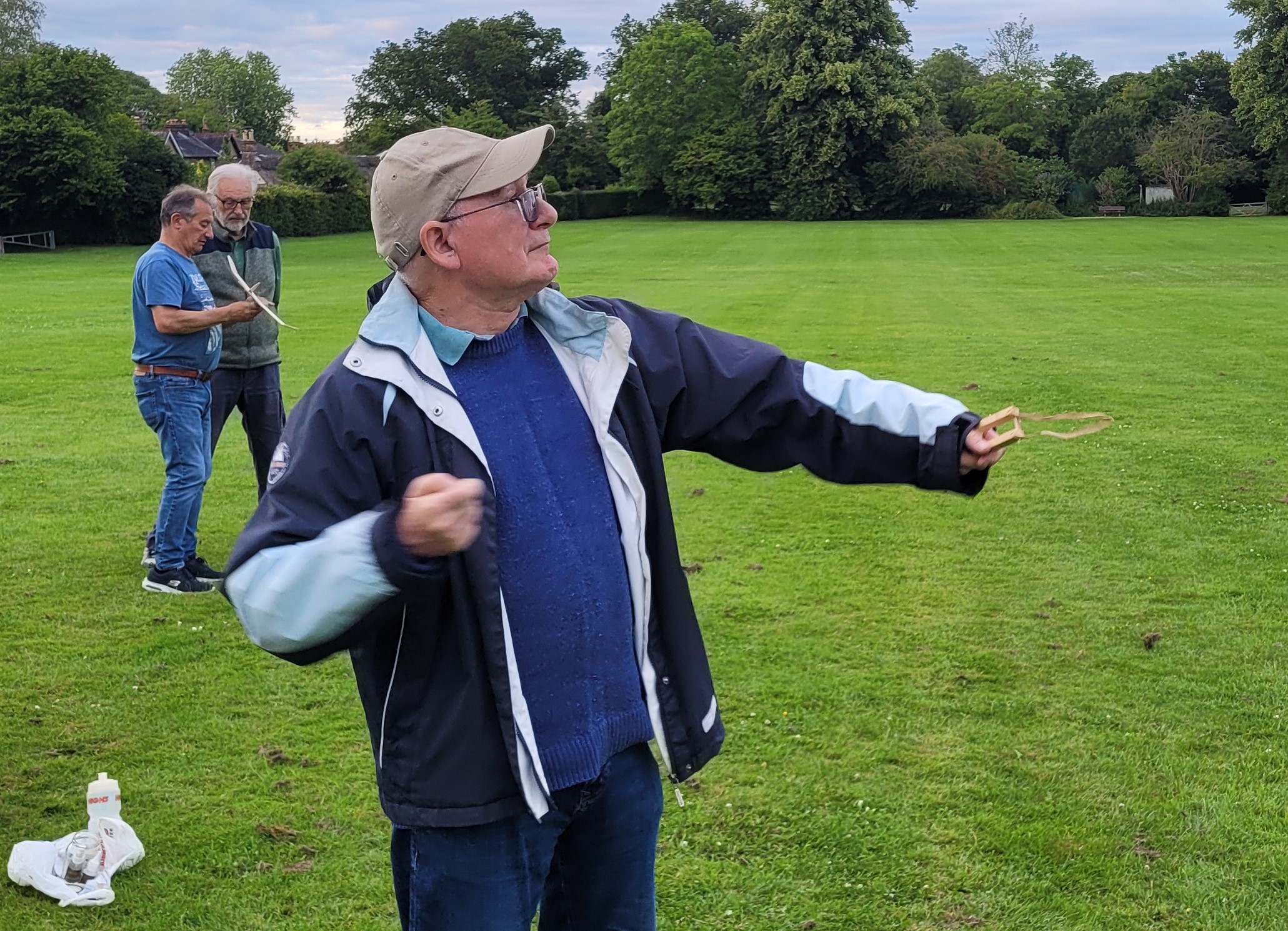

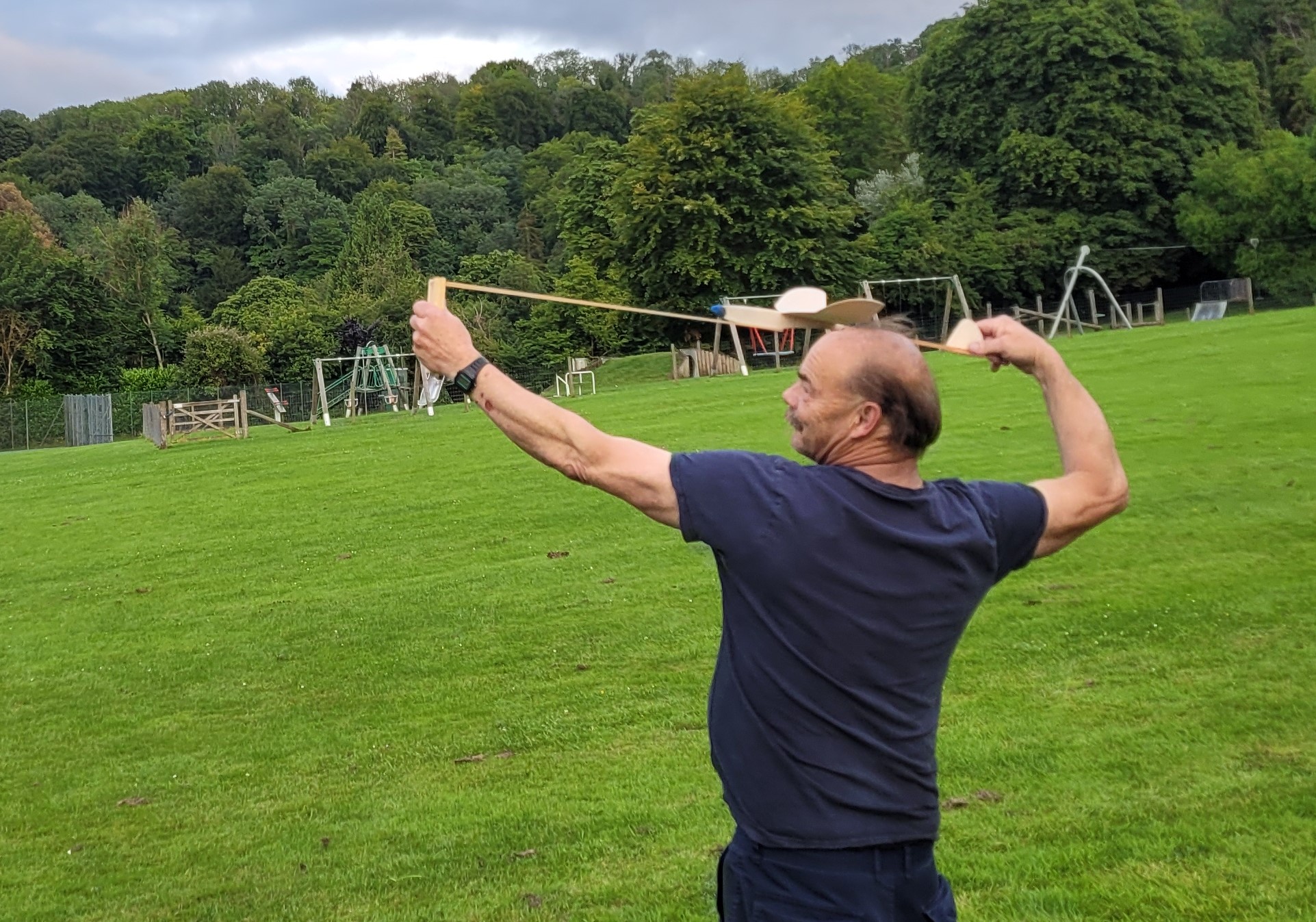 However, he may be losing his touch as his overall time of 56.1 seconds this year was considerably less than the 82.1 second, he won in last year. Second place was Dougal Entendre and MacFly came third. We also had the Catapult Glider competition as well and the results were completely different with Woody coming first and Tony Neil second.
However, he may be losing his touch as his overall time of 56.1 seconds this year was considerably less than the 82.1 second, he won in last year. Second place was Dougal Entendre and MacFly came third. We also had the Catapult Glider competition as well and the results were completely different with Woody coming first and Tony Neil second.  Everyone seemed to have a good time. I would recommend for next year that you get lots of practise in trimming your aircraft before you turn up on the night.
Everyone seemed to have a good time. I would recommend for next year that you get lots of practise in trimming your aircraft before you turn up on the night.
Thanks Dwayne, it was, as always, a good evening of fun and we all enjoyed it.
In the May Patch News I featured Gordon Bennett’s Fosdyke Flyer, a model that he bought when the club was auctioning off John Bourne’s models and equipment.
 John is an extremely capable modeller who was a PAM member for many years but old age has caught up with him and his modelling days are sadly over. In May Gordon told us all about the work he’d done preparing the model for flight but he hadn’t flown it at the time.
John is an extremely capable modeller who was a PAM member for many years but old age has caught up with him and his modelling days are sadly over. In May Gordon told us all about the work he’d done preparing the model for flight but he hadn’t flown it at the time.
 However, on a nice calm day in July the Fosdyke lived up to its name and flew. And it flew very nicely too, just needing the thrust line adjusting as it climbed steeply at full throttle.
However, on a nice calm day in July the Fosdyke lived up to its name and flew. And it flew very nicely too, just needing the thrust line adjusting as it climbed steeply at full throttle. 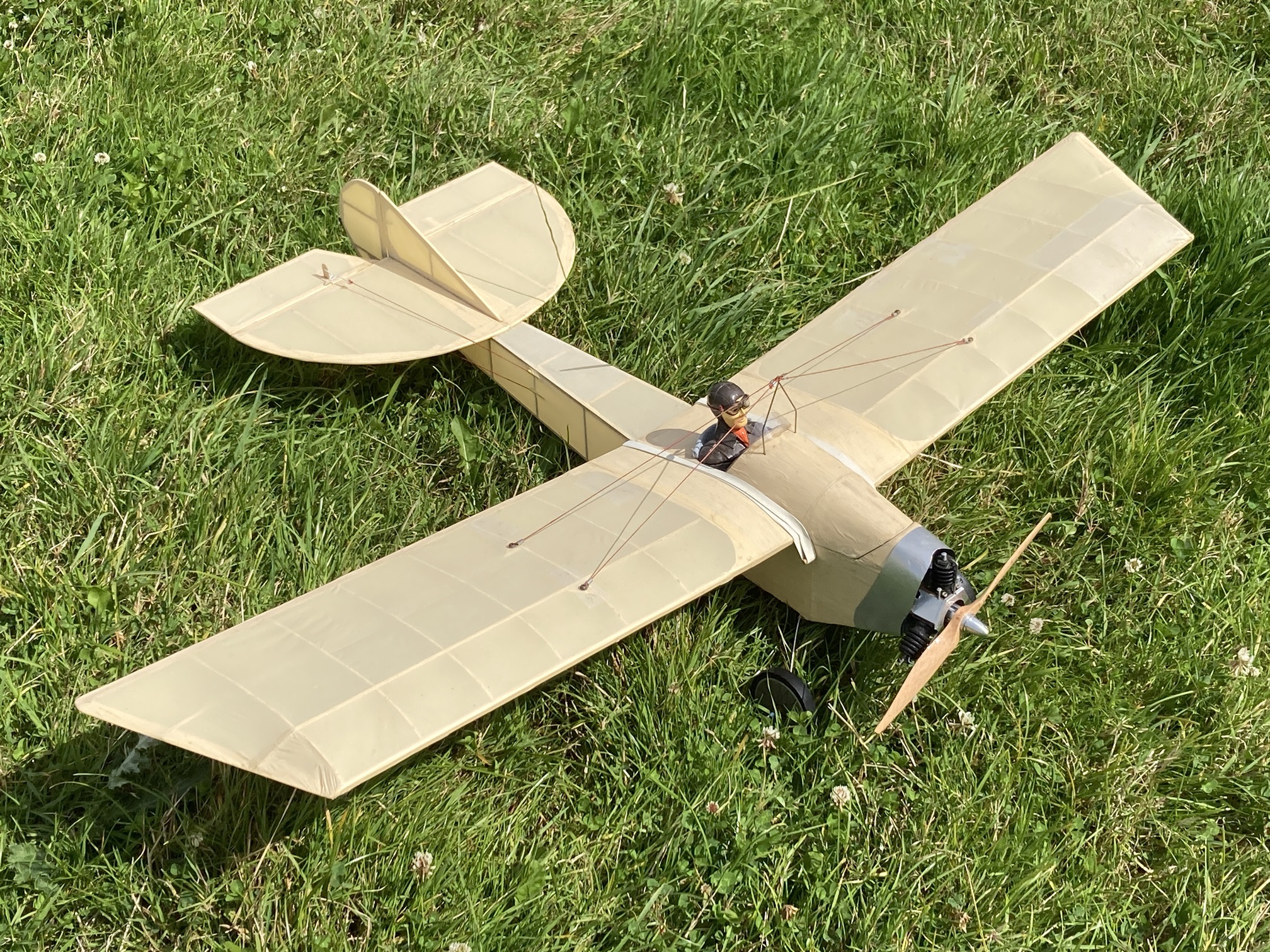 Gordon has since added some downthrust and flown it again and, as you’ll see in the video, it performed beautifully. We need to see it flying circuits with Captain Slow’s Junior 60.
Gordon has since added some downthrust and flown it again and, as you’ll see in the video, it performed beautifully. We need to see it flying circuits with Captain Slow’s Junior 60.
The last new model to feature this month is Mini-Mike’s lovely Arrows Hobby Avanti.
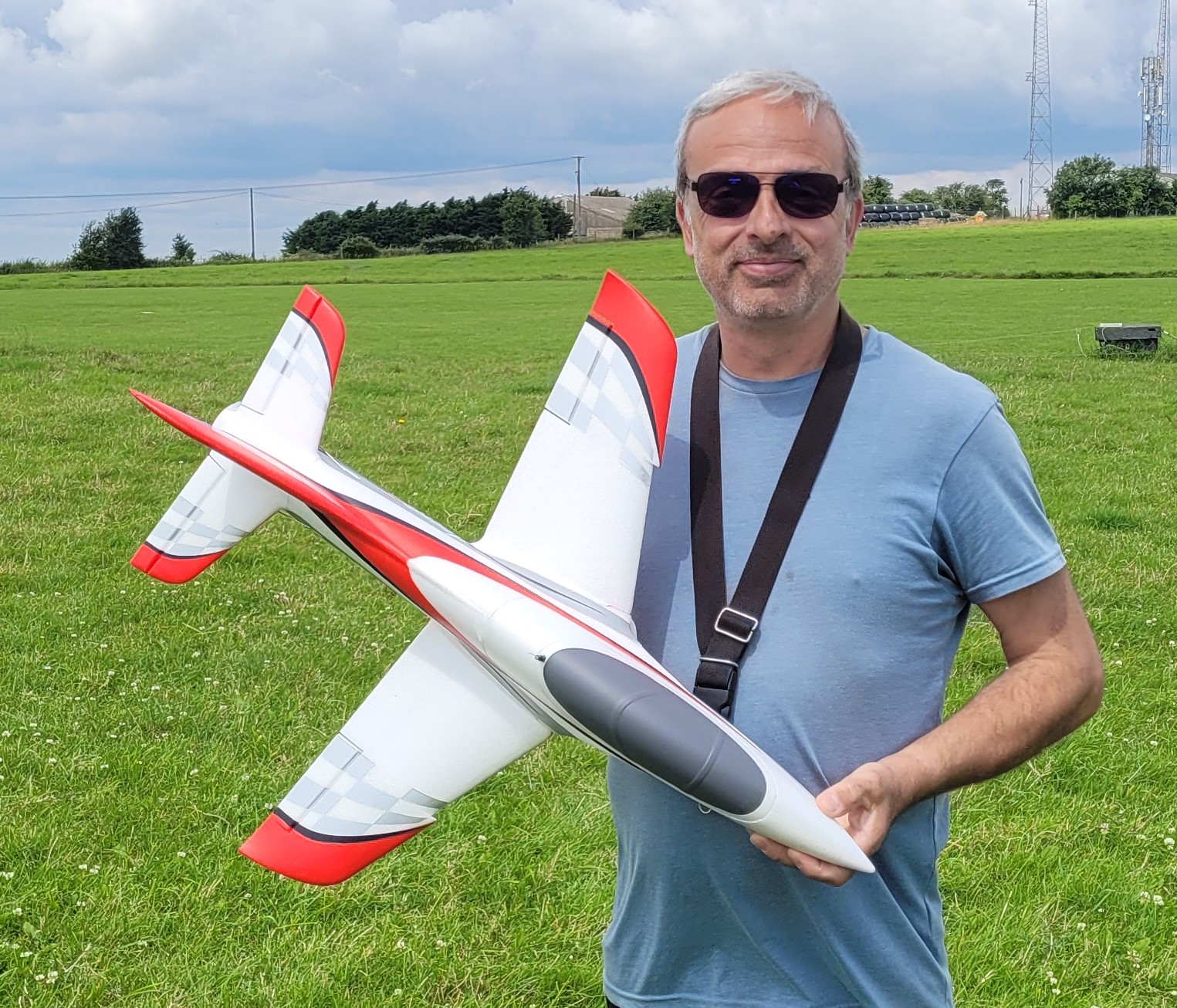
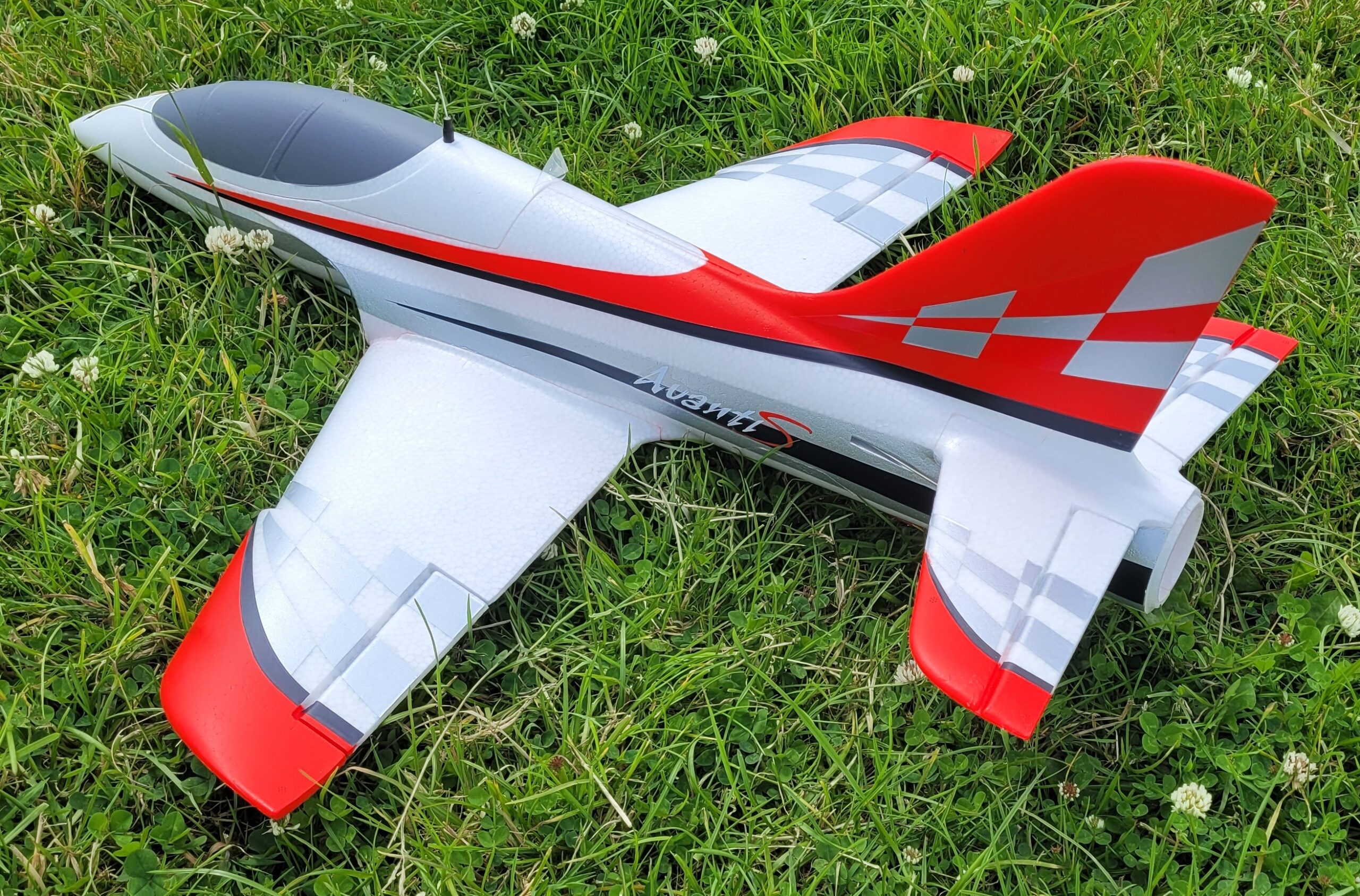 I have a suspicion that he likes the Arrows edf range and to date he has the Marlin, Hawk, Viper, Albatross, and now the Avanti. It’s another in the 50mm fan range and is very similar to the others, especially the Viper. I’ve always liked the look of the Avanti, it’s one of those designs that just looks right somehow. The Avanti comes with a pre-installed 2627 4500KV brushless motor spinning at 11 bladed 50mm fan. That is exactly the same motor and fan combination as the others but oddly the recommended battery is a 3 cell 1300-1600mAh rather than a 2200mAh that all the others use. Mike uses a 2200mAh anyway but it needs to be positioned a fair way back to get the correct centre of gravity.
I have a suspicion that he likes the Arrows edf range and to date he has the Marlin, Hawk, Viper, Albatross, and now the Avanti. It’s another in the 50mm fan range and is very similar to the others, especially the Viper. I’ve always liked the look of the Avanti, it’s one of those designs that just looks right somehow. The Avanti comes with a pre-installed 2627 4500KV brushless motor spinning at 11 bladed 50mm fan. That is exactly the same motor and fan combination as the others but oddly the recommended battery is a 3 cell 1300-1600mAh rather than a 2200mAh that all the others use. Mike uses a 2200mAh anyway but it needs to be positioned a fair way back to get the correct centre of gravity.
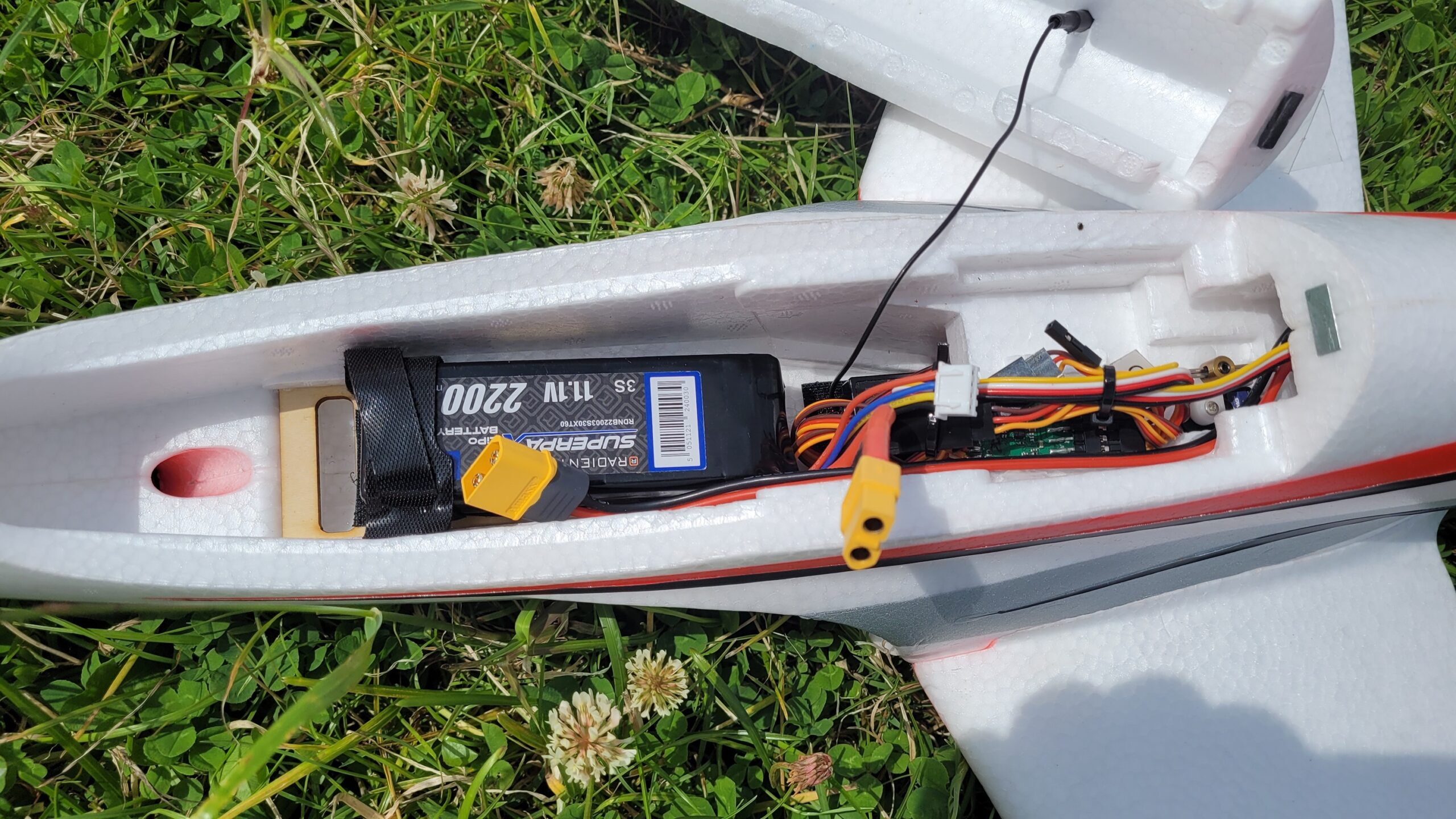 The Avanti comes with a Vector 6-axis gyro and three 9g servos and it all simply screws together with the quoted assembly time being just thirty minutes. Mini-Mike reckons it’s really nice to fly, very smooth, and of course you can see it in this months’ video.
The Avanti comes with a Vector 6-axis gyro and three 9g servos and it all simply screws together with the quoted assembly time being just thirty minutes. Mini-Mike reckons it’s really nice to fly, very smooth, and of course you can see it in this months’ video.
Dougal brought out his large Spad to fly when the weather improved at the end of the July.
 I’ve featured it before so won’t bore you with too many details but it’s an ARTF Spad XIII made by Maxford USA, is 68” wingspan and weighs around 13lbs with 2 x 4 cell lipo packs.MacFly shot some lovely film of the flight and I think it’s worthy of its own video.
I’ve featured it before so won’t bore you with too many details but it’s an ARTF Spad XIII made by Maxford USA, is 68” wingspan and weighs around 13lbs with 2 x 4 cell lipo packs.MacFly shot some lovely film of the flight and I think it’s worthy of its own video.
Unfortunately Kryten was busy this month and was unable to take any action shots for us. So I’ve taken some screenshots from the video which are of lower quality but hopefully ok.

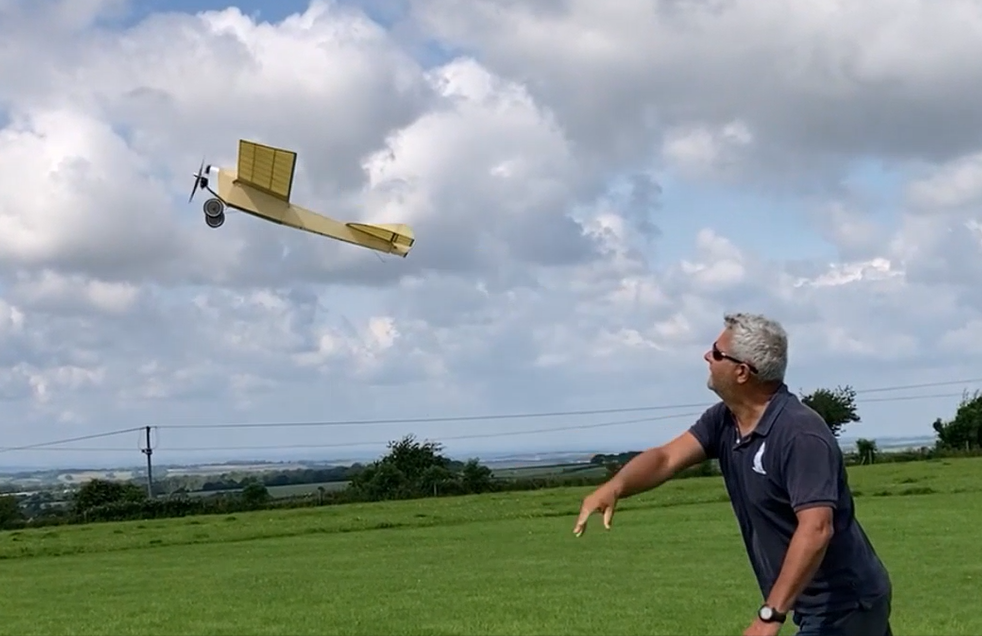



Video time now this month with footage taken by myself, Dougal, and MacFly. Please watch the video full-screen, it’s so much better with small models flying around:
If the video won’t play for you please click HERE
A friend told me he wanted to start making scale models.
I said “be realistic…”
Colin Cowplain


A particularly good Patch news this month with a lot of new models. Well done Colin
Excellent Patch News, Colin!
I can’t give a positive identification of Rod’s inverted gull-wing model, but I found something close-ish at the bottom of what appears to be a South African soaring blog:
https://springfieldchickens.blogspot.com/2013/01/it-is-fate-september-fate.html
This seems to be the only reference to a “CF772 Skyrider” on the web though, and it looks a bit different from Rod’s model in certain details.
Steve’s Fusion isn’t the first plane to be called Fugly: I remember that there was a kit for a fun-flier called a Fugly a few years ago. There’s some info about it here: https://forums.modelflying.co.uk/index.php?/topic/37740-fugly-electric-model/